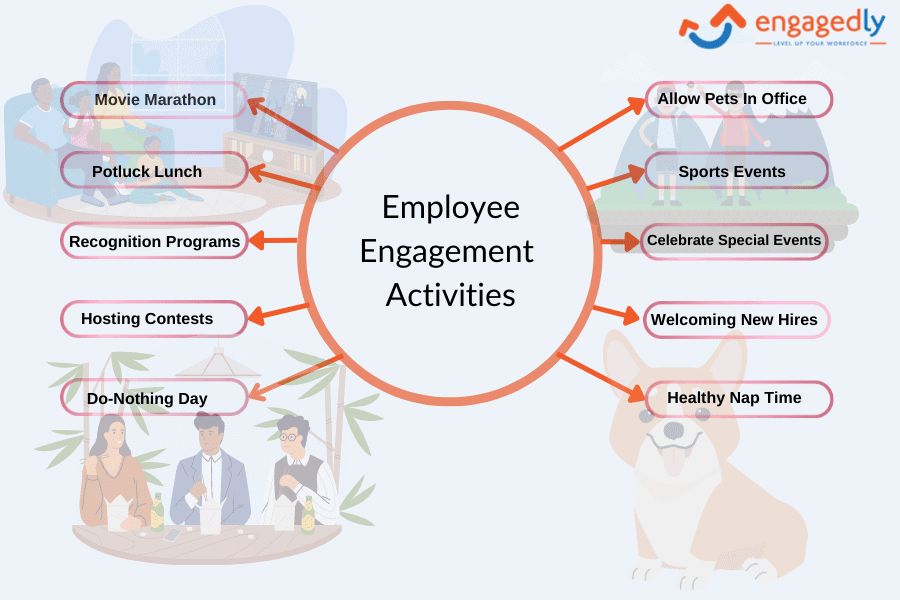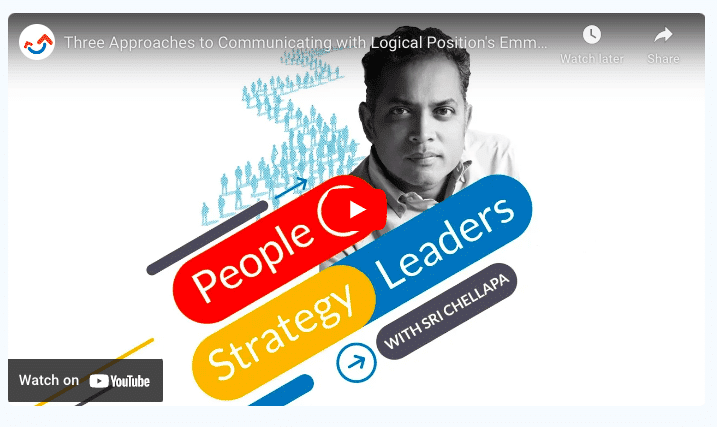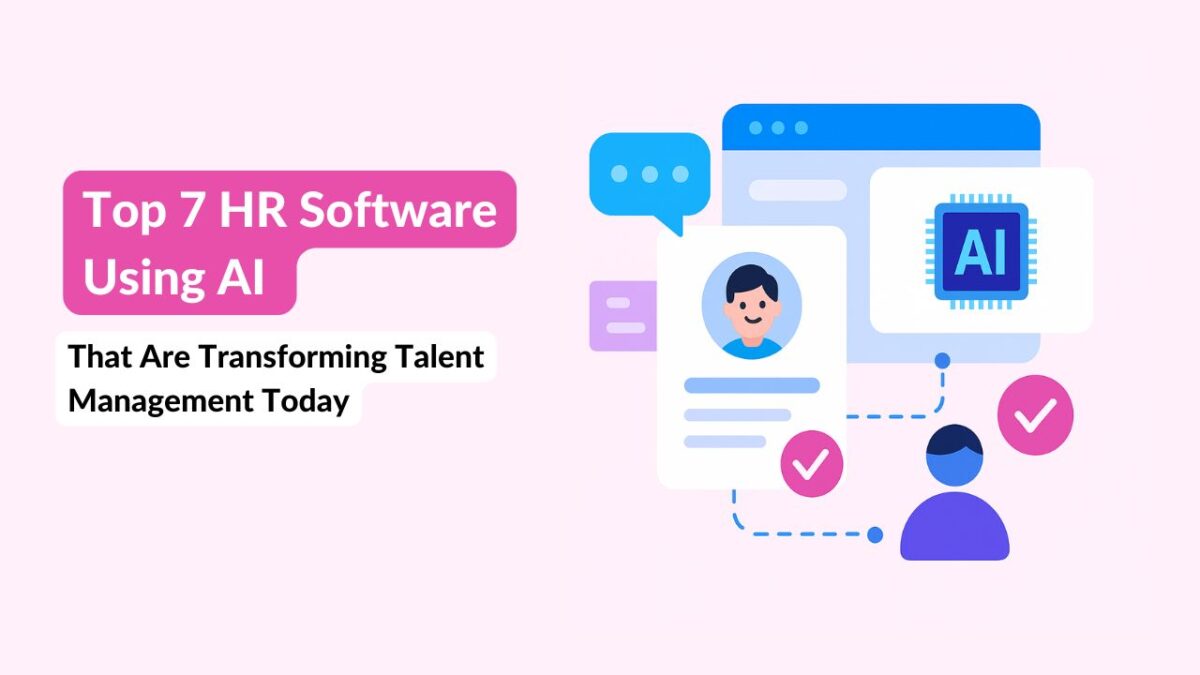Lack of recognition in the workplace is one of the leading causes of employees quitting at unprecedented rates. Yet 83% of organizational leaders believe that employee recognition is not one of their strategic priorities.
Continue reading “Is Lack Of Employee Recognition Damaging To The Company?”Author: Kylee Stone
Pros and Cons of Taking Breaks Throughout the Workday
Finding the right balance between work and breaks can significantly influence productivity and well-being. While taking breaks has its perks, there are also potential downsides to consider.
In this article, we’ll explore both the advantages and disadvantages of breaks during the workday and provide actionable productivity tips to help you make the most of your time.
Ready to enhance your work routine? Let’s get started!
- The Pros of Taking Breaks Throughout the Workday
- The Cons of Taking Breaks Throughout the Workday
- 3 Productivity Tips for the Workplace
- Summing Up
- Subscribe to the Engagedly Newsletter
The Pros of Taking Breaks Throughout the Workday
Taking regular breaks isn’t just a luxury. It’s a necessity for maintaining high performance and overall health.
Increased Work Performance
Regular breaks can enhance overall work performance. One study found that short relaxation, socialization, and cognitive breaks significantly improve sales performance and general work engagement.
Additionally, engaging in activities that draw attention away from work tasks has boosted performance. By stepping away from tasks, employees can return with renewed energy and a clearer mind, leading to better results and efficiency in their work.
Also Read: The Complete Guide To Workplace Competencies
Improved Physical and Mental Well-Being
Taking breaks provides more than just work-related benefits. Research has revealed that breaks throughout the workday can lead to the following physical and mental health improvements:
- Reduced physical discomfort and strain
- Increased physical activity
- Improved psychological and emotional health
- Lowered stress and tiredness levels
Regular breaks encourage movement, reducing the risk of physical ailments like back pain, and help alleviate mental stress, contributing to a healthier work environment.
Reduced Fatigue
Consistent work without breaks can cause fatigue, decrease productivity, and increase the likelihood of errors. Taking numerous short breaks, or microbreaks, has been shown to help preserve high levels of vigor and alleviate fatigue.
Participants in a study reported that lunchtime breaks involving walks in the park or relaxation exercises led to better concentration and less fatigue in the afternoon. Relaxation exercises were also linked to lower levels of strain. This results in a more sustainable and productive work pace throughout the day.
Improved Creativity
Stepping away from work tasks can boost creativity. For example, one study found that taking walking breaks improved creativity for a resounding 81% of participants, with walking outside producing the most significant improvements.
Breaks provide a mental shift that can lead to new perspectives and innovative solutions. Allowing the mind to wander or engage in different activities during breaks can stimulate creative thinking and problem-solving abilities when returning to work.
Also Read: Why Does Workplace Communication Matter?
The Cons of Taking Breaks Throughout the Workday
While breaks can be beneficial, they also have potential downsides that need to be managed effectively.
Ineffective Breaks
Not all breaks are equally beneficial. Ineffective breaks, such as scrolling through social media or staying at a desk, can fail to provide the necessary mental and physical relief.
Taking smoke breaks can also be included in this category. With 15% of Americans smoking e-cigarettes and 11.5% smoking cigarettes, it’s important to note that smoke breaks are not considered effective.
Some examples of more effective breaks include:
- Going for a walk
- Stretching
- Stepping outside for fresh air
- Practicing breathing techniques
- Socializing
Distractions
Breaks can sometimes lead to distractions. Once an employee steps away from their work, they might extend beyond the intended break time by getting caught up in a conversation or activity, such as learning about the newest video marketing trends. This can lead to longer periods of disengagement from work and disrupt the overall workflow.
Increased Workload Pressure
Taking breaks might seem counterproductive due to the pressure of meeting deadlines and managing heavy workloads. This can lead to employees rushing to complete tasks after breaks, causing stress, increased errors, and reduced work quality.
It’s important to promote a balanced approach to breaks in the workplace. For example, HR can ensure employees do not feel guilty for taking necessary pauses and help them manage workload effectively to avoid exacerbating these pressures.
Also Read: Proven Ways To Become A Better Leader In The Workplace
3 Productivity Tips for the Workplace
Check out these three tips to help increase productivity in the workplace:
1. Implement Time Blocking
Time blocking involves scheduling specific blocks of time for different tasks throughout the day. This method helps in maintaining focus and reducing multitasking, which can enhance productivity. By dedicating fixed periods to particular activities, employees can manage their workload more effectively and ensure that important tasks receive adequate attention.
2. Try Out Different Break Techniques
Experimenting with various break techniques can help find the most effective method for maintaining productivity.
- 52-17 Rule: This technique involves rotating between working for 52 minutes and taking a break for 17 minutes.
- Pomodoro Technique: This technique involves rotating between working for 25 minutes and taking a break for 5 minutes.
- 90-Minute Work Blocks: This technique involves rotating between working for 90 minutes and taking a break for 20 minutes.
- Microbreaks: This technique involves taking numerous 1–5-minute breaks throughout the workday.
3. Engage in Movement and Stretching
Incorporating short physical activities or stretching exercises into the workday can significantly boost productivity. Movement helps reduce physical strain and increases blood flow, leading to improved energy levels and mental clarity. Simple exercises or a quick walk can refresh the mind and body, making it easier to return to tasks with renewed vigor.
Ready to take your productivity to the next level? Incorporate these tips and transform your workday!
Also Read: Dealing With Workplace Stress[Infographic]
Summing Up
Balancing breaks with work can be a game-changer for productivity and well-being. By understanding the pros and cons, you can tailor your break strategy to maximize benefits and minimize drawbacks.
Start refining your workday routine today and see the difference it makes in your performance and overall well-being!

How To Interpret Your Employee Engagement Survey Results
Your employee engagement survey results have just arrived but now what? Gone are the days when you could conduct a poll just to tick a to-do box and ignore the results or skim over the negative parts.
Whether positive or negative, employee engagement surveys offer a treasure trove of information that HR departments and management can use to better engage and motivate employees at all levels. To do so, you need to first correctly interpret the survey findings, of course.
The employee survey data gives you an identifying of the main areas to focus on, which is the first step in creating a successful employee engagement action plan. No company can be expected to respond with every bit of feedback. Instead, People Insight suggests utilizing the findings of your employee survey to highlight a few areas to improve – the things that are most important to your staff.
In this article, we will discuss exactly how to do this, and the various assumptions and biases one must be aware of when analyzing employee engagement survey results.
Why Analyze Employee Engagement Survey Results?
Employee surveys are a direct approach to learning what your employees think of your company, the issues they experience, and the changes your company can make. The effectiveness of these enhancements is determined by your ability to read and analyze employee survey findings.
Unfortunately, the majority of organizational initiatives are ineffective. In reality, according to the data, just 25% of employees believe that their company takes highly efficient responses to the feedback they offer.
Taking the wrong action or disregarding (even unintentionally) employee input can have serious ramifications for your company. When their firm does not act on their input, for example, approximately 1 in 5 staff becomes disengaged. Employee disengagement may have a detrimental influence on your workplace culture as well as productivity and profitability. Do not fall victim to this. Make data-driven modifications based on the input you get and share the outcomes with your staff. You maintain open channels of contact with your staff by looping back thereafter.
Also Read: How To Create A Good Employee Engagement Survey?
Types of Employee Engagement Survey Results
Staff opinions concerning issues impacting your organization such as bad attitudes, employee attrition, and lower productivity, are captured in several employee engagement surveys. Here are a few types of employee engagement survey results:
Employee Satisfaction Survey
Employee Satisfaction Surveys are useful for determining overall happiness as well as staff satisfaction following a specific change like a layoff, merger, or business relocation.
 Business Improvement Survey
Business Improvement Survey
Business Improvement Surveys might reveal difficulties you didn’t realize you had, such as managerial or training concerns. Such surveys can also raise staff morale by demonstrating that you respect their input.
360 Degree Feedback Survey
360 Degree Feedback statistics tell you and the employees how others see him and how he perceives himself, as well as offer ideas for growth. The survey also shows the employee that you value his previous work and acknowledge his talents and achievements.
Exit Interview Survey
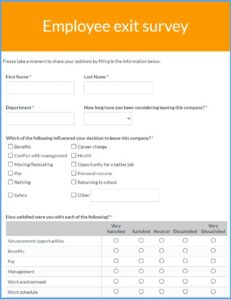
This sort of survey helps in figuring out why workers depart and how to minimize future attrition by making operational changes. This survey can also assist you in reversing a valuable employee’s choice to quit by revealing that the staff is inclined to remain provided you make certain modifications to his work demands, training, promotion possibilities, salary, or general working circumstances.
Also Read: All You Need to Know About Employee Engagement Surveys
Key Metrics and Indicators in Employee Engagement Survey Results
In employee engagement survey results, several key metrics and indicators provide insights into the overall health and satisfaction of the workforce. Some of the essential metrics include:
- Overall Employee Engagement Score: A composite score that reflects the overall level of engagement across the organization. It is often calculated based on responses to key survey questions.
- Job Satisfaction: Measures employees’ contentment with their roles, responsibilities, and the work environment. It can be an indicator of overall morale and happiness at work.
- Employee Net Promoter Score (eNPS): Assesses employees’ likelihood to recommend their organization as a good place to work. It provides an indication of employee loyalty and advocacy.
- Communication Effectiveness: Evaluates how well information is communicated within the organization. It assesses the clarity, transparency, and accessibility of communication channels.
- Leadership Effectiveness: Measures employees’ perceptions of leadership, including trust in leadership, communication from leaders, and confidence in leadership decisions.
- Recognition and Rewards: Assesses whether employees feel adequately recognized for their contributions and if the rewards system is perceived as fair and motivating.
- Career Development Opportunities: Indicates employees’ satisfaction with opportunities for professional growth, skill development, and career advancement within the organization.
- Work-Life Balance: Measures how well employees feel their work and personal lives are balanced. It reflects the organization’s commitment to employee well-being.
- Team Collaboration: Assesses the effectiveness of teamwork and collaboration within the organization. It provides insights into team dynamics and cooperation.
- Employee Feedback and Performance Reviews: Gauges employees’ satisfaction with the feedback and performance evaluation processes, including the frequency and quality of feedback received.
- Employee Inclusion and Diversity: Assesses perceptions of inclusivity and diversity within the workplace, reflecting the organization’s commitment to creating an inclusive environment.
- Intent to Stay/Retention: Measures employees’ likelihood to stay with the organization. It can be an early indicator of potential turnover issues.
Analyzing these key metrics in employee engagement survey results helps organizations identify areas of strength and areas that require improvement, guiding strategic initiatives to enhance overall employee satisfaction and engagement.

How to Analyse Employee Engagement Survey Results?
It’s critical you act quickly when your staff survey has ended. This demonstrates that people’s voices have been heard and valued. Employee engagement survey results must be shared and implemented across the firm and among team members for maximum impact.
1. Quantify the information
Results that are quantified (numeric scores) are a clear and meaningful approach to conveying them. Everyone can recall numbers. This also facilitates data comparison.
For example, displaying the percentages of various respondents’ responses to a survey item might help us better grasp the general trend.
2. Dissecting the data
Everyone’s employment experience is different. By fragmenting your data by staff groups and demographics, you may gain a better understanding of the issues that various workgroups face. This will help to compare the performance of different teams and take some action where it is really needed.
3. Look for trends and patterns
Look for patterns in your survey data. What is significant to one individual may be meaningless to another. It’s striking when 80 percent of respondents indicate they’re unhappy with the overtime pay-off policy. Maybe not so much when a few employees want an additional short break during the day.
- Are the replies uniform throughout the company?
- Are there any distinctions between FTEs and hourly employees?
- What about experienced employees versus new hires?
These questions will assist you in identifying changes that will have the greatest impact.
4. Pay attention to qualitative replies as well
Don’t only focus on the figures. Make sure you pay equal attention to both quantitative and qualitative comments. These reactions are significant because they go deeper than quantitative (numerical) data. It’s what makes the narrative come alive.
Numeric responses without context can be inaccurate since they don’t account for other aspects. Motivations, cognitive processes, and attitudes may all be captured using a qualitative technique.
5. Trust your intuition
Don’t overlook your first-hand experience and instincts when conducting data analysis. You are also an important element of your company.
Consider whether the data makes sense in light of the company’s culture and conditions. While objective analysis is important, don’t disregard your instincts.
Look into any differences between your personal observation and the results. To learn more about the statistics, think about sending an open-ended follow-up survey or hosting a small focus group. This will assist you in grasping the larger picture.
6. Compare and contrast your survey findings
Benchmarking your performance can help you gain a better understanding of how your company is performing and discover opportunities for improvement.
There are three sorts of benchmarks to utilize when reviewing survey data: national, industrial, and internal benchmarks.
7. Set priorities for the changes you wish to make
It’s time to prioritize your results after you’ve reviewed your survey data. To begin, go over each item in the questionnaire and assign it to one of three categories:
- “Strong,”
- “Neutral,” or
- “Needs Work.”
Having a solid mix of improvements is also a good idea. Concentrate on both short-term successes (1 to 3 months) and long-term gains. This will demonstrate to your personnel that you are going to act and will enable you to take on greater tasks.
8. Visualize your information
Data visualization aids in capturing the attention of your staff and stakeholders. Our brains comprehend visual information more quickly and are less prone to mistake it. There are various sorts of graphics that may be used to represent survey data, such as pie charts, bar graphs, etc.
It’s time to address back once you’ve ‘digested’ the facts. Taking action is the most critical component of assessing your survey data. Your employees will become accustomed to the procedure and appreciate your candor if you report your survey answers on a regular basis. Even if you’re not happy with the outcomes, communicate them. Consider it a chance to encourage openness and staff participation in the solutions.
What methods of communication are most effective in your workplace? Does everyone use the same platform? If not, use different communication methods to spread the message.
Consider going through the adjustments and improvements you made in answer to the survey. Make a note of whether or not scores are growing over time. This demonstrates the company’s dedication to employee input.
Conclusion
Are you ready to start driving effective employee engagement at your organization? We’ve created a comprehensive white paper on exactly how you can do that. Download now.
Terrific numbers equal great employees. Numbers are entirely objective and will protect us from partiality and nepotism. A good score is crucial, especially for people in the service industry. Top scores can be used to create a survey. The findings of an employee engagement survey are one of several tools available to small company owners to help them improve interactions with their staff and develop their enterprises.

Peer Feedback In Workplace: Definition | Types | Importance
Peer feedback in the workplace is an effective method for growth and development that, when implemented properly, can benefit both individual employees and the company overall. While the idea of providing and receiving feedback from coworkers may seem daunting or uncomfortable to some, research has consistently shown that peer feedback fosters improved communication, cultivates interpersonal skills, and drives better performance when incorporated into an organization’s culture regularly.
Done right, peer feedback leads to a more collaborative and supportive work environment where employees feel empowered to provide meaningful input to help one another strengthen weaknesses and enhance strengths. In this post, we will explore the definition of peer feedback, identify its different types, and discuss its importance for both employees and employers seeking to nurture an inclusive, learning-oriented culture.
Continue reading “Peer Feedback In Workplace: Definition | Types | Importance”5 Companies Embracing Diversity and Inclusion Through Initiatives
Today’s business landscape has organizations purposely strengthening their commitment to diversity and inclusion, demonstrating solidarity with and support for marginalized employees. Many businesses now understand that fostering an inclusive environment benefits society and positively builds the company’s image.
Modern-day businesses are promoting diversity, equality, and inclusion (DEI) as HR professionals get more aware of these aspects in hiring. Such an approach impacts a company’s culture and financial performance as they create a disability-inclusive workplace, promote equal pay across genders, and hire people from different backgrounds. A few companies drive DEI by taking impactful initiatives to help businesses grow.
Some stats on how DEI can boost business:
BCG highlights that businesses with solid commitments to DEI may witness up to a 19% increase in revenue.
- Gartner’s research suggests that team members in diverse and inclusive environments experience a 12% boost in productivity.
- Moreover, Josh Bersin’s research suggests that the innovation level in companies that promote inclusivity can rise 1.7 times.
Here, let us look at some trailblazing companies actively driving diversity and inclusion initiatives. They are focusing on their innovative strategies, inspiring stories, and making a tangible impact with their hiring strategies.
The Business Case for DEI
Research indicates that companies with strong DEI commitments experience tangible benefits:
- Increased Revenue: Organizations with solid commitments to DEI may witness up to a 19% increase in revenue.
- Enhanced Productivity: Team members in diverse and inclusive environments experience a 12% boost in productivity.
- Innovation Growth: The innovation level in companies that promote inclusivity can rise 1.7 times.
These statistics highlight the positive correlation between DEI initiatives and organizational performance.
5 companies driving diversity and inclusion
The fast-growing global business environment demands an inclusive workplace. It is no longer a luxury but necessary for companies seeking long-term success. Creating an inclusive culture pushes many organizations to take key steps to offer a friendly environment to workers from different backgrounds, experiences, and perspectives.
Comcast and NBCUniversal

These telecommunications and media conglomerates have an internal advisory council comprising senior leaders to maintain diversity and inclusion. It currently has a workforce where 62% are women and people of color, and now they aim to have 50% women and 33% people of color at every level of its workforce.
The organization also boasts a Comcast NBCUniversal Joint Diversity Advisory Council (JDAC) consisting of national leaders from various communities representing different backgrounds. It includes Asian Pacific Americans, African Americans, Hispanics, Native Americans, women, and people with disabilities. The JDAC helps shape the company’s policies and practices to ensure that diversity and inclusion are integral to the business.
On the community work front, they have helped struggling businesses during the pandemic by offering free webinars on reworking their goals and using new technology. It also offered two months of free Internet to low-income households. Also, they collaborated with Goodwill Industries International to help thousands of low-income persons learn digital skills and advance their careers via Goodwill’s network of nonprofits in the United States.
Also Read: The Go To Guide To Perfecting The Employee Engagement Survey
General Motors

General Motors (GM) brew thoughts around the need for a world and their organization to progress toward a fairer future. They comprehend that their brand represents more than just the vehicles they manufacture and market. Therefore, GM is taking initiatives to champion human dignity, fairness, acceptance, and inclusivity.
Recently, they have taken a stand against law enforcement violence, racial prejudice, bias, discrimination, and harassment. General Motors Chairman and CEO Mary Barra united with nine other prominent leaders from various sectors at Detroit City Hall to express unwavering support for justice and equality for all Americans.
Moreover, GM has committed $10 million to aid organizations working towards racial equality and inclusion. Of this amount, $1 million has been designated for the NAACP Legal Defense and Education Fund. The remaining $9 million will be distributed to organizations GM’s Employee Resource Groups recommends.
The company also houses an Inclusion Advisory Board with internal and external leaders collaborating to tackle the systemic obstacles that impede inclusivity. This board is responsible for determining which resources and financial contributions the company will make to combat social injustices until they are fully eradicated from society.
General Motors observed a moment of silence for 8 minutes and 46 seconds on June 19, 2020, Juneteenth, in honor of George Floyd and all African Americans who had been killed because of their race.
Also Read: 6 Reasons in Favor of Fostering a People-Centric Workplace
Johnson & Johnson

Johnson & Johnson allocates substantial resources to ensure every staff member contributes to cultivating an inclusive atmosphere. The company nurtures a worldwide vision of ‘be yourself, change the world’ to motivate individuals to collaboratively harness their distinctive experiences, skills, and backgrounds. The aim is to ignite solutions that foster a healthier and more improved global community.
Johnson & Johnson boasts 12 Employee Resource Groups (ERGs) that connect and engage employees, help build relationship capital, embrace their potential, and create an inclusive environment and culture. The company aims to achieve a 50% representation of women in management positions worldwide by 2025. The organization aims to achieve a 35% representation of diverse races in its management positions while operating in the United States. The company has been featured on the Working Mother 100 Best Companies list for 28 consecutive years.
Also Read: Tips on Communicating better in a Hybrid Work Environment
Accenture

Accenture is ranked one by Refinitiv’s Diversity and Inclusion Index since it demonstrates robust dedication to fostering a sense of belonging and equality. This company strongly supports flexible work arrangements and employee growth, allocating $1.1 billion to learning and development initiatives for its workforce.
Moreover, Accenture is working towards achieving a gender-balanced employee base, with females currently comprising 47% of the organization’s staff. The company also actively champions the LGBTQ+ community, boasting 120,000 Pride allies worldwide across its areas of operation.
They are known for providing fair opportunities to people with disabilities as well. Accenture maintains 32 international centers for individuals with disabilities to access resources, technology, and assistance to excel in their respective roles.
Dedicated to cultivating an inclusive and varied work setting, Accenture emphasizes its Inclusion & Diversity initiatives. They have introduced the Advocates for Persons with Disabilities (PwD) program, which emphasizes recruiting, educating, and assisting those with disabilities. Furthermore, they provide a range of employee support groups and training programs centered on diversity to promote an inclusive workplace culture.
Also Read: The Growing Trend of Gamification in HR
Microsoft

Microsoft earns substantial positive feedback regarding its efforts to empower female employees in the tech industry. Some of Microsoft’s data on inclusion and diversity is worth noting.
- Women now represent 29.7% of the global workforce at Microsoft, an increase of 1.1 percentage points from 2020 to 2021.
- Since 2020, the proportion of Hispanic and Latinx workers in the United States has increased by 0.5 percentage points to 7.0%. In the last five reporting periods, this is the highest annual growth we’ve seen.
- By the end of the fiscal year 2021, 7.1% of Microsoft’s core workforce in the United States had chosen to disclose a disability. Compared to June of 2020, this is an increase of 1%.
Microsoft has been actively working to promote diversity and inclusion within the company and the tech industry with some of the following impactful initiatives:
- Employee Resource Groups (ERGs): Microsoft supports more than 40 ERGs that cater to various communities within the company, such as women, people with disabilities, LGBTQ+ individuals, and ethnic minorities. These groups provide a platform for employees to network, support one another, and drive positive change within the organization.
- Microsoft is committed to increasing the diversity of its workforce by implementing inclusive hiring practices. This includes offering internships and job-shadowing programs for students from diverse backgrounds; partnering with organizations that support underrepresented groups in the tech industry.
- Beyond Microsoft program to close the gender gap, cultivate young talent, and study sociology, psychology, behavioral science, and neuroscience to better understand what causes exclusion. This helps develop strategies for altering their patterns of thought and behavior which serves as input for future hiring.
- The company is dedicated to creating accessible technology for people with disabilities. Microsoft has an internal accessibility team developing new technologies and features. It ensures that their products and services are accessible to everyone, regardless of their abilities.
Also Read: 5 Lessons from Remote and Hybrid Work That Last
Navigating the Political Landscape: DEI in 2025
The political climate in 2025 has significantly impacted corporate DEI initiatives. Notably, Harvard Business School concluded its $25 million Racial Equity Action Plan, initiated in 2020, amid a broader national trend of retrenching DEI efforts.
Furthermore, a directive from Attorney General Pam Bondi in February 2025 targeted DEI-related practices perceived as discriminatory, leading major corporations such as Disney, Meta, and Target to scale back or eliminate their DEI policies to align with the administration’s stance.
These developments underscore the complex and evolving nature of DEI efforts in the current socio-political environment.
Conclusion
The journey towards diversity and inclusion in the workplace is an ongoing process that requires commitment, investment, and genuine intent from organizations. The top five companies highlighted in this blog have demonstrated their dedication to fostering a people-centric workplace with inclusive work environments. And then, initiatives range from targeted hiring practices and leveraging employee resource groups to running community engagement programs.
These companies inspire others to follow, showing that embracing diversity and inclusion is a moral standpoint that collectively works as a strategic business decision to drive innovation, boost employee satisfaction, and increase overall performance.
Frequently Asked Questions
Q1. Why is diversity and inclusion important?
Ans. Diversity and inclusion are crucial because they foster innovation, enhance creativity, and promote equal opportunities, leading to better problem-solving and more sustainable and fair societies.
Q2. How to promote diversity and inclusion in the workplace?
Ans. To promote diversity and inclusion in the workplace, it is important to create a culture of respect and acceptance. This can be achieved by implementing inclusive hiring practices, providing diversity training, fostering open and transparent communication, establishing employee resource groups, promoting diverse leadership, and continuously evaluating and addressing biases.
Q3. What is the difference between diversity and inclusion?
Ans. Diversity refers to the presence of a wide range of individuals with different backgrounds, perspectives, and identities. Inclusion, on the other hand, is the act of creating an environment where all individuals feel valued, respected, and empowered to contribute their unique perspectives. While diversity focuses on representation, inclusion emphasizes creating a sense of belonging and ensuring that diverse voices are heard and valued.
Author: Aanya Rachel
Aanya Rachel is the Content Manager at The Address, a coworking space in Indore, Madhya Pradesh. She’s passionate about sharing her knowledge, experience, and extensive research in this field. She writes on various topics related to coworking, the growth of remote workers, digital marketing, startups, and real estate.
Do’s and Don’ts of Giving 360 Feedback!
The struggle with 360-degree feedback does not always deal with the act of giving feedback in itself. Rather, it might deal with trying not to be burnt out while attempting to give good, actionable feedback to a number of people.
Continue reading “Do’s and Don’ts of Giving 360 Feedback!”Employee Engagement Activities That Your Employees Will Love
Employee engagement is essential for every organization. Now that employees are returning to the office after a long gap of two years, they are certainly going to experience some hiccups in settling down.
But as a manager, you can help them get past the initial inhibitions to get connected with their team members and try to enhance their engagement in the workplace culture. You can try out some employee engagement activities that will motivate employees and push them to take more ownership and responsibilities.
We all know how important employee engagement is. However, only a handful of organizations have been able to understand that it is a continuous and ongoing process. To reap the benefits of a highly engaged workforce, leaders need to keep working on some strategies to make employees feel more involved and valuable in the workplace.
To help you get started with employee bond building, we have come up with a list of 22 out-of-the-box employee engagement activities that you can carry out on a budget! If the budget is not a constraint, take a look at 6 creative ideas for employee engagement!
An employee engagement survey can help you get the pulse of your workforce. Understanding their concerns and problems should be your priority. Check out our step-by-step guide on how to create and utilize an employee engagement survey in your organization.
Take a look here. “Your Ultimate Guide To Employee Engagement Survey And Templates”.”
The Importance of Employee Engagement
According to a 2024 Gallup report, organizations with highly engaged teams see 21% higher profitability and 17% higher productivity. Implementing cost-effective engagement activities can significantly contribute to these outcomes.
22 Employee Engagement Activities for 2025
While there are multiple ways to engage employees, it is important to use activities that put them at the center. Here are the ten amazing employee engagement activities for 2022.
1. Movie Marathon
This employee engagement event is simple and self-explanatory. On a Friday evening or any day really, ask your employees to come armed with a mat and a snack of their choice, queue up a list of movies, and get to watching!
Employee engagement is not just about how invested an employee is in the organization. Employees also need to know and experience that it is okay to relax and have fun in the workplace. Engagement is not about work alone!
2. Breaking Bread (Potluck Lunch)
You can divide this activity into teams and groups based on the number of people in your organization. All that needs to happen is that each person needs to bring in one dish that they want to share with everybody. Food breaks many barriers and will give your employees a chance to relate to each other on a level that is not work-related. You can also incorporate knowledge-sharing sessions to foster learning and bond-building.
Also Read: 6 Tools to measure employee engagement
3. Recognition Programs
Saying a few kind or good words about a colleague and their accomplishments (weekly or bimonthly, that’s up to you) takes next to no effort and does not cost any money at all. Maybe every Friday, you could set aside an hour in the evening when colleagues and managers can praise a fellow employee.
4. Hosting Contests
A contest that has a reasonable objective that can be met and an adequate reward for meeting the objective is a surefire way to give your employees adequate cause to be engaged.
Incentives have always been a great way to motivate and engage employees. You just need to figure out what objective needs to be met and which reward should be offered. These contests need not be big office-wide contests. Rather, it can be specific to each team, and the manager of the team will be the one who decides the objective and the reward.
Also Read: Smart goals for employee engagement
5. Do-Nothing Day
Before you scoff, hear us out. The ideal employee should be engaged. However, they shouldn’t be so engaged that they actually burn out because of all the hard work they are putting in. A do-nothing day is exactly what it means—a day where you do absolutely nothing. Let your employees come to the office, chill out, hang out, talk to colleagues, talk to people other than their team members, and basically view the office as a place where they can also relax and have fun, besides working hard!
6. Allow Pets In Office
Employees love it when they can just walk into the office with their pets and watch them while working. You can also create some special events in which employees can dress up their pets and get themselves clicked in the office. Gifting them a loveable picture of their pets will surely make them happy. Moreover, such events will help employees break barriers and connect with each other.
7. Sports Events
Sports bring people together. There is no doubt that people love to be involved in sports activities, and offering them that right in the office will cheer them up. It also leads to team building, ideation, and brainstorming. Just book a basketball, baseball, or cricket field and invite employees to let their inner sportsmen shine. Furthermore, for employees who are interested in some indoor activities, you can utilize some office space for organizing events.
8. Celebrate Special Events Like Birthdays And Work Anniversaries
You want to see your employees happy on their special days. Singing happy birthday for them and gifting them a personalized card will break shackles and help them connect better within teams. You can also go a step ahead and decorate their cubicle or the whole bay to make them feel special.
9. Welcoming New Hires
Your employee engagement activities should not be restricted to only tenured employees. It must encompass new hires right from their very first day in the office. Gifting them a welcome card or some nice gadgets that they can use to increase their productivity and understand their work will make them feel included and part of the company from the first day.
10. A Healthy Nap Time
Well, this might sound a bit odd, but it works wonders for employees. Our biological clocks work differently, and many people find it difficult to stay productive for the whole day without taking some time out for rest. Offering your employees some nap time in the office will enhance their productivity and keep them focused on work.
11. Book Clubs
Engaged employees are the most valuable resources for an organization. It is the responsibility of leaders to focus on creating a healthy, happy, and productive environment where engagement can be cultivated.
We hope the employee engagement activities discussed in this article will be helpful to you.

Engaging Remote and Hybrid Teams
In today’s work landscape, fostering engagement among remote and hybrid teams is crucial. Here are some budget-friendly activities:
- Virtual Coffee Breaks: Encourage informal interactions by scheduling regular virtual coffee breaks where employees can chat about non-work topics.
- Online Trivia or Game Sessions: Host virtual trivia games or online escape rooms to promote teamwork and fun.
- Digital Recognition Platforms: Utilize platforms like Matter to send shoutouts and kudos, celebrating achievements and fostering a culture of appreciation.
Subscribe To The Engagedly Newsletter
Communication Skills for Introverts for Workplace Success
Mastering the art of communication is a valuable skill that can enhance interactions in any situation or setting. Whether engaging with challenging individuals or navigating difficult conversations, some individuals effortlessly maintain meaningful dialogues. Their ability to establish rapport and handle tough situations can make communication appear effortless and seamless.
Continue reading “Communication Skills for Introverts for Workplace Success”Why 360-Degree Feedback is Essential: 10 Benefits You Need to Know
Recent studies indicate that a significant majority of Fortune 500 companies continue to utilize 360-degree feedback as a central component of their leadership development strategies, reflecting its sustained relevance and effectiveness in contemporary organizational settings
The feedback system is often overlooked in employee management, despite its significant advantages of 360-degree appraisal. While employees typically receive feedback from their managers during quarterly or annual performance reviews, this may not be sufficient.
Peer feedback is essential for enhancing employee performance as colleagues may have a better understanding of the nature of work than managers. Thus, receiving feedback from peers brings additional advantages of 360-degree feedback in helping employees improve.
Understand 360-Degree Feedback from the following insightful video.
Why is 360 Degree Feedback Important?

In 360 degree or multirater feedback, managers, peers, direct reports, and sometimes even customers, consultants, and vendors are involved in the feedback process. It provides an overall analysis of the performance of the employee in the organization.
Here are the main reasons why 360-degree feedback is important in today’s workplace:
- Provides a comprehensive evaluation of employee performance from different perspectives
- Promotes a culture of openness and transparency within an organization
- Enables informed decision-making about employee development, promotions, and job assignments
- Identifies potential leaders and areas where employees need support or guidance
- Aligns individual goals with organizational objectives, leading to improved organizational performance and greater success.
- Encourages Continuous Improvement: Promotes ongoing development by highlighting specific areas for growth.
- Builds Trust and Engagement: Boosts engagement and trust by recognizing contributions from all perspectives.
- Reduces Bias in Evaluations: Balances performance reviews by including diverse viewpoints.
- Fosters Accountability and Ownership: Encourages accountability as performance is assessed broadly.
- Enhances Team Dynamics: Improves team support through understanding of each other’s skills.
10 Benefits of 360 Degree Feedback
360 degree feedback is an employee development tool that helps in building a skilled, dynamic, engaged, and productive workforce. Due to its innumerable advantages, most of the Fortune 500 organizations are using it for workforce development. The following section talks about the benefits of 360 feedback in an organization.
1. Increases Self-Awareness
“In a study conducted by Gallup among 65,672 employees, it was discovered that those who received feedback had 15.9% better turnover rates than employees who received no feedback.”
360 feedback is a valuable tool for enhancing employee self-awareness and identifying their strengths and weaknesses. By utilizing this process, employees can gain insight into their hidden strengths and weaknesses, which they may not have been aware of previously. The comprehensive nature of the 360 degree review process allows employees to gain a better understanding of their behavior and approach to work, ultimately leading to improved performance.
2. Offers Objective Evaluation
360 degree feedback provides the employee with a scope to get multiple inputs for their role, performance styles, and ideas. It provides a well-balanced view of the behavior and skills of the employee. It helps employees to know themselves from others’ perspectives and bridges the gap between what they think of themselves and what others think of them. This feedback system is constructive and more acceptable for the employees.
Also read: 10 Best Employee Feedback Tools To Track Performance
3. Reduces Workplace Bias
In a multi rater feedback process, feedback is collected not only from the manager but also from peers, subordinates, direct reports, and sometimes even customers. As a result, the feedback received in the 360-degree review process is completely impartial as it is not based on single person assessment. It helps in reducing managerial biases, which are often prevalent in the traditional feedback system.
4. Emphasises Employee Development
“According to Skills Gap Report, nearly 80% of Americans agree there is a skills gap, and more than a third (35%) say it affects them personally.”
Every employee should prioritize professional development to progress in their career. The 360 feedback process is a useful tool for identifying employee training needs and skill development opportunities.
Since employees become more self-aware through this process, they take responsibility for improving their existing skills and acquiring new ones. This not only leads to employee growth but also benefits the organization by increasing employee engagement and retention.
5. Improves Decision making
360-degree feedback is an excellent tool for managers to gain valuable insights into employee performance. This helps managers make informed decisions about employee development, promotions, and job assignments. With feedback coming from multiple sources, managers can identify employees’ strengths and areas for improvement.
This information helps managers provide targeted training and development programs that enable employees to grow in their roles. Additionally, 360-degree feedback highlights potential leaders and helps managers prepare them for leadership roles. This approach leads to better decision-making, improved employee performance, and organizational effectiveness.
6. Improves Work Relationships
“In a study of 530 organizations, Gallup reported that managers who received feedback showed an increase in 8.9% profitability and 12.5% productivity.”
In traditional one-to-one feedback, the one who receives feedback from superior generally has nothing to say from their side as it is one-sided. There is no sense of personal connection in this type of feedback process. But in 360 feedback, as superiors and subordinates review each other, it improves the superior-subordinate relationship. Everyone’s morale is boosted, and employees and managers work together to achieve mutual goals.
Also read: Benefits of 360 feedback for leaders
7. Creates Open Culture
Multi rater feedback helps in promoting a sense of an open culture in the organization where it is implemented. Every employee feels that their opinion is valued as they take part in the review of their peers and managers. The feedback process becomes the medium to share their opinions without having a fear of getting repressed.
8. Promotes Team Building
In a 360 degree feedback process, peers review each other frequently. They understand each others’ weaknesses and strengths very well, which helps them to work as a strong and cohesive team. They work collectively to improve the productivity of the organization. An effective team is one where each team member knows how to use each other’s strengths and weaknesses effectively and get the result.
Also Read: How do you prepare your team for a 360 degree review process
9. Improves Customer Relationship
When customers are made part of this feedback process, they feel that they are valued and given importance. Since employees work closely with the customers, sometimes they can identify certain strengths and weaknesses that even managers, peers, and others fail to identify during the 360 feedback process. Thus, it helps in improving customer service when organizations ask customers to be a part of the process.
10. Enhances Performance
One of the most important benefits of a 360-degree feedback process is the enhanced performance of employees. It helps in improving employee relationships, and self-accountability, and provides clarity on how to improve overall performance. This, in turn, improves employee engagement and retention of the organization. They feel valued since importance is given to their professional development, learning, and their opinions.
Companies that leverage the benefits of 360 degree feedback often see higher levels of employee engagement, as the inclusive feedback process makes employees feel heard and valued
Advantages of 360 degree appraisal
1. Holistic Feedback
One of the primary advantages of 360 degree appraisal is its holistic approach to gathering insights from multiple sources: peers, subordinates, managers, and sometimes even customers. This way, you get a comprehensive picture of an employee’s performance.

For instance, imagine a team leader known for hitting targets but not for communication. Feedback from team members might reveal that they need to work on delegation and empathy, while their manager praises them for strategy. Together, this feedback gives a fuller, more balanced view.
2. Identifies Blind Spots
We all have areas we think we’re doing well in but may actually be our weak points. A 360-degree review can reveal these blind spots. Let’s say Priya, a manager, thinks she’s a great listener. Her team, however, might say she tends to interrupt during meetings. This feedback highlights something Priya wouldn’t notice on her own, giving her a chance to improve.
3. Encourages Personal Growth
Knowing how peers perceive you can be an eye-opener and a motivator for self-improvement. For example, if an employee receives feedback that they often shy away from presenting their ideas, they may feel inspired to speak up more. Over time, with some encouragement and practice, they grow more confident and make a bigger impact on the team.
4. Strengthens Team Relationships
The 360-degree appraisal fosters a culture of transparency, where team members feel comfortable sharing honest feedback. Imagine a scenario where teammates are hesitant to tell a employee about his overly detailed emails that take too much time to digest. With a 360 review, they can communicate this constructively, leading to a more streamlined communication style and better team dynamics.
5. Aligns Personal Goals with Organizational Goals
This appraisal method allows employees to understand how their performance aligns with company goals and what adjustments are needed.
If Rina’s feedback shows she’s strong in creativity but less focused on deadlines, her manager might set specific time management goals to bring her performance in line with the team’s expectations, boosting productivity without stifling her creativity.
6. Enhances Accountability and Engagement
Knowing that everyone’s feedback matters can create a stronger sense of ownership. For instance, when team members know that their opinions count toward a colleague’s development, they become more invested in the team’s success. This mutual accountability can improve engagement and commitment, as everyone feels they’re part of a supportive and cohesive unit.
How Engagedly’s 360-Degree Feedback Empowers Organizations
Traditional performance evaluations often lack crucial perspectives, relying solely on manager assessments. This can lead to incomplete evaluations, hindering employee development and organizational growth. Engagedly’s 360-degree feedback module tackles this limitation, providing a comprehensive approach to performance assessment that benefits both individuals and organizations:
Enhanced Employee Development:
Multi-rater Feedback: Engagedly’s 360-degree feedback gathers input from peers, managers, direct reports, and even clients, offering a holistic view of an employee’s strengths, weaknesses, and areas for improvement. This self-awareness empowers employees to take ownership of their development and chart a focused path for growth.
Targeted Development Plans: With a comprehensive understanding of their performance, employees can collaborate with managers to create personalized development plans. These plans leverage strengths, address weaknesses identified by diverse perspectives, and align with individual career aspirations.
Improved Management Effectiveness:
Unbiased Insight: Managers gain valuable insights into their own leadership style and how it impacts team performance. Peer feedback sheds light on communication, collaboration, and delegation practices, allowing managers to identify areas for improvement and refine their leadership approach.
Strengthened Team Dynamics: 360-degree feedback fosters open communication and builds trust within teams. By understanding how colleagues perceive each other’s strengths and weaknesses, teams can address interpersonal challenges, improve collaboration, and build a more cohesive working environment.
Data-Driven Decision Making:
Actionable Insights: Engagedly’s platform analyzes 360-degree feedback data to identify emerging trends and patterns within the organization. This data helps inform strategic decisions related to talent development, team building, and overall performance improvement initiatives.
Increased Performance Visibility: Leadership gains a bird’s-eye view of the organization’s strengths and weaknesses through aggregated feedback data. This enables them to identify areas requiring intervention, allocate resources effectively, and track progress towards improvement goals.
Engagedly’s 360-degree feedback module goes beyond simply providing data. It fosters a culture of continuous feedback and development, leading to:
Enhanced Employee Engagement: Feeling valued and supported by colleagues and managers increases employee engagement and motivation.
Strengthened Employer Branding: Organizations that prioritize employee development attract and retain top talent.
Improved Customer Satisfaction: A collaborative, engaged workforce translates into superior customer service and satisfaction.
Engagedly’s 360-degree feedback module is more than just a tool; it’s a catalyst for organizational transformation. By providing a holistic view of employee performance, empowering development, and informing data-driven decisions, it unlocks the full potential of both individuals and teams, driving sustainable success for the entire organization.
Also Read: 8 Points to Ensure an Effective 360 Feedback Process
Measuring the Effectiveness of 360-Degree Feedback
To maximize the benefits of 360-degree feedback, organizations should establish clear metrics to assess its impact. Key performance indicators (KPIs) such as improvements in employee performance, engagement levels, and retention rates can provide valuable insights. Regularly reviewing these metrics allows organizations to refine their feedback processes and ensure alignment with overall business objectives.
Conclusion
360-degree feedback is more than just a performance evaluation tool — it’s a powerful mechanism to foster growth, collaboration, and self-awareness across all levels of an organization. When implemented thoughtfully, it helps employees understand their strengths, identify areas for improvement, and align their development with organizational goals.
In today’s hybrid and digital workplaces, leveraging technology to collect and act on feedback ensures that all employees, whether remote or on-site, have equal opportunities for development. Regularly measuring the impact of feedback initiatives also ensures that the process remains meaningful and drives tangible improvements in performance, engagement, and team dynamics.
Ultimately, organizations that embrace 360-degree feedback as a continuous learning tool, rather than a one-time assessment, create a culture of openness, accountability, and growth — a culture where both employees and the organization can thrive together.

How to Manage Grapevine Communication in an Organization
People talk. Some people talk more than others, and that’s okay. But in the workplace, the way they talk can have an impact on the company as a whole.
In this article, we’re going to look at grapevine communication. We’ll explore what it is and how you can make sure it works for your organization rather than against it.
What is grapevine communication in the workplace?
Grapevine communication is the informal, word-of-mouth way that news, gossip, and even rumors spread in the workplace. It’s what happens when employees exchange information casually—whether in hallways, during coffee breaks, in the lunchroom, or even in online chats—rather than relying on official memos or meetings. This type of communication can flow in all directions, from peers to higher-ups, or even across departments that don’t typically interact.

No matter how sophisticated your company’s communication systems are, they will never fully replace the casual, off-the-cuff conversations that happen naturally.
Email and messaging apps are great for work-related tasks, but small talk by the coffee machine or during lunch is never going out of style. We’re social creatures, after all, and these moments of casual chatter are where grapevine communication thrives.
Think about it: someone overhears a snippet of conversation or notices something unusual, and soon that information spreads across the company. Maybe you hear over lunch that Matt is in line for a big promotion to Head of Sales. Before long, hundreds—or even thousands—of employees are buzzing about it.
And before any formal announcement, people are already reacting: some are excited, and others may feel resentment, thinking they were more deserving of the role. This is how grapevine communication moves—fast and often without all the facts.
It’s a double-edged sword. On one hand, the grapevine can spread accurate, timely information faster than formal channels. But on the other hand, it can carry half-truths, misinterpretations, or outright rumors that lead to confusion or tension. Its unchecked nature means that it can have a powerful influence on workplace morale and culture, for better or for worse.
And while it can be tricky for managers to handle, grapevine communication is a natural part of any organization. It’s not something that can—or should—be shut down completely.
In fact, a study by the Society for Human Resource Management (SHRM) found that 70% of workplace communication happens through the grapevine. That shows just how much influence these informal conversations hold, often more than official announcements.
Rather than trying to eliminate it, the key is to recognize its upsides and manage its downsides. Grapevine communication fosters social connections and can boost morale, but it’s essential to monitor how it’s impacting the workplace environment to prevent misinformation from spreading too far.
Also read: How to Improve Internal Communication in the Workplace
Advantages and drawbacks of grapevine communication
It’s a tricky business, the grapevine. On the one hand, it can be an incredibly valuable way of getting information across fast. On the other, it can get out of control pretty quickly.
Let’s now take a closer look at the pros and cons.
Advantage 1: Generates new connections
Even in large organizations, it’s often the case that people work with the same small set of colleagues every day. This is a double-edged sword. It can be easier to foster a positive team spirit among a smaller number of people who feel more socially connected. But without broader social interaction across your organization, everyone could be missing out on some excellent collaboration opportunities.
The more chances your teams have to mingle and interact on an informal basis, the more likely they’ll find new partners for peer-to-peer learning or cross-team cooperation. This benefits everyone in the long run.
Advantage 2: Team bonding
There’s no getting away from it: your organization will be much more successful if everyone in it gets along. Now, it’s unrealistic to expect all team members to be the best of friends. There’s bound to be the occasional personality clash—that’s par for the course in any community.
Nevertheless, it’s more likely that people will be happy and productive if they can chat freely. And the inevitable side effect of being able to do that is grapevine communication.
Let’s face it—the sharing of knowledge is an integral part of human interaction. Learning information and passing it on to others encourages an atmosphere of mutual trust.
Advantage 3: Efficient information sharing

The speed of light may be faster than anything else, but the rate rumors spread is close behind. That’s down to powerful network effects. It doesn’t matter whether a piece of information is passed one-to-one down a chain or through multiple people at once. If it’s being communicated informally, it’s reaching many ears quickly.
This can be particularly useful for senior managers. Generally speaking, the higher up the career ladder you go, the more isolated you are from opinions on the ground. Many organizations use feedback procedures to try to address this issue.
However the grapevine can cut out the intermediary and help leadership identify potential problems. In some circumstances, it can be as effective as 360-degree feedback.
Also read: How Internal Communications can Align Your Employees with Organisational Goals?
It’s not all good news, of course. Grapevine communication can cause some genuine headaches. In particular, watch out for:
Drawback 1: Misinformation
This is a big one. A major downside of this kind of communication is that the information shared is unverified. In fact, the process can function a bit like a social media misinformation bubble. When the message being shared is untrue, you have a real problem on your hands.
Trouble is, this can lead to serious conflict, particularly if the misinformation is something negative about an individual’s behavior. Reputations are difficult to restore once trust has gone. And it doesn’t do much to foster team spirit if people are at loggerheads. In some cases, you may even be looking at an expensive lawsuit.
Drawback 2: Sensitive information can reach the wrong people
Every organization has sensitive data it needs to keep confidential. This could be anything from client details that can only be shared with a core team to upcoming hybrid integration plans that will transform the current workflow. It’s a fact of workplace life.
Unfortunately, the grapevine can sometimes stretch a little too far. Imagine your organization is in the difficult position of considering laying people off. If employees get to hear about it in advance, that’s not good for team morale. Even if layoffs are eventually avoided, trust between management and employees will have taken a permanent hit.
Drawback 3: Reinforces inequality in the workplace

The flip side of the team bonding benefit is that some people will be excluded. By its very nature, grapevine communication tends to pass through chains of more extroverted and sociable individuals. Anyone who’s naturally inclined toward keeping themselves to themselves will miss out on the bonding.
This can become a problem if you rely too heavily on the grapevine as a communication channel. Let’s say it becomes normal for internal job opportunities to be discussed on the grapevine before they’re made official. This could give an edge to those who are prime influencers in the grapevine chain—and actively work against anyone who isn’t.
Ultimately, this can be bad for employee engagement, and reinforce many other kinds of inequality as well. So, while senior managers can sometimes harness this kind of informal channel and use it to their advantage, it’s important to keep it in check.
However, if organizations prioritize transparency in the workplace, many of these drawbacks can be addressed. By providing open channels of communication and regular updates on company policies and changes, employees are less likely to rely on the grapevine for information. In turn, this can help reduce misinformation, reinforce trust between employees and management, and promote a more inclusive and equitable work environment. Here’s how.
Also read: Why Does Workplace Communication Matter?
How to manage grapevine communication in an organization
There are several ways to manage grapevine communication. All of them are aimed at benefiting from the upsides while limiting the potential damage from the downsides.
1. Regular communication with staff
First, foster a culture of transparency. Regular official communication about recent developments will ensure employees are kept fully informed. That means there’ll be fewer gaps in the narrative that can be filled by misinformation.
This isn’t just a technical issue, like how to integrate Slack and Gmail for more efficient messaging. It’s a human one. Managers at all levels should encourage their direct reports to come to them with any issues. Make it clear that there’ll be no penalties for doing so.
2. Know where and how informal communications are happening

Actively monitor your grapevine; don’t let it function under the radar. This doesn’t mean spying on staff or invading their privacy—it’s just about keeping your ear to the ground and noticing what’s going on around you. Figuring out who the most enthusiastic participants in the chatter vine are shouldn’t be too tricky.
Occasionally, you may find an individual is actively spreading untrue rumors or gossip. In this case, it’s best to step in with a one-to-one meeting to warn them off.
Try to keep it low-key though. The worst thing you can do in this situation is send an all-staff email demanding an end to rumor-mongering. All that will do is supercharge the rumor mill while everyone tries to figure out who the guilty party is.
3. Make sure your corporate policies are fit for purpose
Finally, you need to ensure your workplace policies are functioning as they should. You may well have formal procedures around harassment or grievance, but how accessible are they?
When considering this, try to see it from another point of view. Put yourself in the shoes of someone who’s the victim of malicious gossip. How realistic is it that they’ll use these policies rather than just leave your organization?
If a commitment to equality and diversity is to be more than just a nice-looking mirage, you need to dig down into the details of how this situation will be experienced by the people living it. It’s crucial to make sure your policies are watertight and work as intended.
Also read: 10 Ways To Improve Communication At Workplace
4. Foster open-door leadership
Encourage leaders at all levels to adopt an open-door policy, where employees feel comfortable sharing concerns and feedback directly. When employees see that leadership is approachable, they are less likely to rely on the grapevine for information.
This openness reduces the appeal of informal channels and promotes a culture of trust. Leaders should regularly engage with staff, host Q&A sessions, and provide updates, creating an environment where employees know they can get accurate information from the source.
5. Leverage the grapevine positively
Rather than viewing the grapevine purely as a source of potential issues, use it strategically. Recognize that employees will naturally talk among themselves, and sometimes this can be beneficial. If you have exciting news or a positive message, allow it to travel through informal channels first.
People are often more receptive to information when it comes from peers rather than official announcements. By feeding positive stories into the grapevine, you can help shape the narrative in a constructive way.
6. Provide training on responsible communication
Equip your employees with the skills to manage and filter the information they hear. Offer workshops or sessions on responsible communication, where employees learn how to handle gossip, avoid spreading rumors, and support colleagues who may be impacted by it.
This proactive approach not only minimizes the potential harm caused by the grapevine but also builds a workplace culture where employees are conscious of the impact their words can have on others.
Grapevine in Digital & Remote EnvironmentsGrapevine in Digital & Remote Environments
In organizations where remote or hybrid work is common, grapevine communication often shifts online. This changes how rumors spread, how fast they move, and who perceives them first.
- Channels multiply: It’s no longer hallway chat or lunch break—all-company Slack channels, private messaging groups, social media, video calls, and virtual coffee breaks serve as informal grapevine hubs.
- Speed and scale increase: Digital grapevines can amplify messages rapidly—sometimes before leadership even becomes aware. A short message in an informal channel can be reshared widely.
- Anonymity and misinterpretation rise: Without facial cues or tone, misunderstandings (or rumors) can escalate, especially in text chats. Anonymously posted rumors or side-channel speculation often cause more harm.
- Leadership visibility becomes more critical: When employees can’t see leaders in person, misalignments between official communications vs. what is heard informally can breed distrust faster.
Strategies specific to digital/remote grapevines:
- Monitor informal online chatter (without being invasive) — through sentiment or pulse tools; keep an ear open in virtual channels.
- Establish clear norms for virtual communication — clarify what kinds of announcements happen where, how rumors should be addressed, and how official messaging relates to informal channels.
- Conduct regular “virtual town halls” or Q&A sessions where leadership addresses concerns heard in informal channels.
- Encourage “digital transparency” — share meeting summaries, decisions, and context via formally distributed channels so that employees don’t rely on hearsay.
Psychological Safety, Trust, and the Grapevine
Unless employees feel safe and trust those in leadership, grapevine communication tends to drift toward fear, rumors, and mistrust. Building psychological safety helps in managing grapevine more healthily.
- Promote a culture where it’s okay to ask questions, express concerns, and admit not knowing. This prevents employees from seeking answers via rumor rather than asking openly.
- Leaders should model vulnerability: admit mistakes, clarify misunderstandings, explain uncertain situations rather than leaving gaps.
- Recognize that people may fear reprisal or judgment for raising concerns. Make clear that sharing feedback or concerns (even negative ones) will not lead to penalties.
- Use inclusive communication practices: ensure quieter team members, remote workers, or those in different time zones have safe channels to share.
- Periodically survey employee sentiment about trust: “Do I trust information from leadership?”, “Do I feel comfortable asking questions?”, “Does rumor spread because I feel uninformed?”
Measuring & Monitoring Grapevine Impact
To know whether your efforts are working—not just good in theory—you’ll want to monitor grapevine communication and its effects. Here are ways to keep track:
| What to Measure | Why It Matters |
|---|---|
| Employee surveys / pulse checks specifically asking about clarity of communication, rumor prevalence, trust in leadership | Helps detect whether people believe they’re getting information versus filling gaps with rumors |
| Sentiment analysis in digital channels | Monitoring tone/trends in informal chats can warn of growing concerns or misconceptions |
| Number of miscommunications / conflicts traced to misinformation | Gives concrete evidence of harm, where to focus corrective efforts |
| Feedback in 1-1s and group meetings about communication transparency | Qualitative input often reveals issues not surfaced in surveys |
| Turnover or engagement metrics in teams where grapevine issues are known to be bad | Correlation helps understand broader consequences of unmanaged grapevine |
| Speed & completeness of leadership responses when rumors surface | How quickly and accurately leadership addresses rumor-based issues signals credibility |
Use measurements at regular intervals. Adjust your strategies based on what you learn: which informal channels are most active, what topics are prone to rumor, what communication gaps exist.
You heard it through the grapevine
In the end, grapevine communication can be a net positive—if it’s handled well. The benefits in terms of increased collaboration and team cohesion can give organizations a massive boost.
Just be sure to encourage a culture of openness too, while also making certain your policies and procedures are clear and effective. This way, everyone will be free to chat happily and make new connections. That’s a win for everyone.
Frequently Asked Questions
Q1. What is the importance of grapevine communication?
Ans. Grapevine communication plays a vital role in organizations as it serves as a natural and informal information network. It allows for the rapid spread of news, ideas, and rumors among employees, often reaching areas untouched by formal channels.
This informal communication enhances employee engagement, fosters a sense of belonging, and facilitates the exchange of tacit knowledge.
Additionally, grapevine communication can provide valuable insights into employee sentiments and concerns, enabling proactive management strategies. Embracing the grapevine can empower organizations to tap into their collective intelligence and adapt swiftly to ever-evolving challenges.
Q2. What are the grapevine communication examples?
Ans. Grapevine communication examples encompass various scenarios that demonstrate its prevalence in organizations. For instance, when employees gather around the water cooler or during lunch breaks to discuss recent company developments, share rumors, or exchange unofficial information, that’s grapevine communication in action.
It can also manifest through casual conversations in hallways, social events, or even virtual platforms where employees freely exchange thoughts and opinions about work-related matters.
These informal channels often facilitate the spread of news faster than official announcements, making grapevine communication an integral part of the organizational communication fabric.
Author: Jenna Bunnell – Senior Manager, Content Marketing, Dialpad
Jenna Bunnell is the Senior Manager for Content Marketing at Dialpad, an AI-incorporated cloud-hosted unified communications system that provides valuable call details for business owners and sales representatives with the virtual PBX by Dialpad. She is driven and passionate about communicating a brand’s design sensibility and visualizing how content can be presented in creative and comprehensive ways. Jenna has written for other domains such as Price2Spy and DivvyHQ. Here is her LinkedIn.
5 Common “Team Collaboration Issues” And How To Overcome Them?
Every organization needs effective team collaboration, yet frequent obstacles might thwart this process. Common team collaboration problems include issues with remote work, different work styles, and generational gaps. Learning to overcome these challenges is important for creating a productive work climate. In this blog, we will discuss some common challenges in teamwork collaboration and the ways to overcome them.
1. Lack of Communication
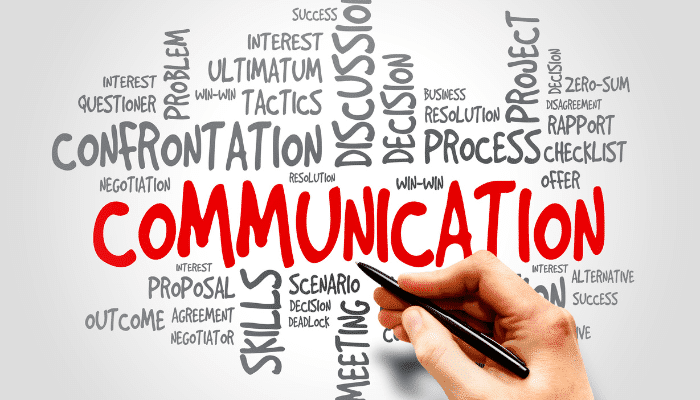
Lack of communication is a serious problem facing teamwork. Research says that workplace success can be negatively impacted by poor communication. In 31% of the cases, it resulted in low employee morale.
When team members do not communicate clearly, information becomes fragmented, misunderstandings occur, and crucial updates may be overlooked. Expensive errors and project completion delays might be the direct consequences in this case.
One effect of poor communication is the duplication of effort, where team members unwittingly labor on the same duties. This results in wasted time and resources. In addition, a lack of communication frequently results in ambiguous expectations and goals. So, aligning team members’ efforts with the team’s objectives becomes challenging.
Poor communication may also lead to feelings of unappreciation among team members. This further lowers motivation and engagement. It may, thus, become difficult to establish a culture of confidence and mutual support among the team.
Solution:
- A simple solution to the lack of communication is to prioritize honest and open communication.
- Routine team meetings and one-on-one check-ins facilitate information sharing.
- The use of collaborative tools guarantees smooth project management.
- It is also essential to promote active listening and offer a secure environment where team members can communicate their ideas and concerns.
Effective communication promotes a sense of belonging and respect. This will ultimately help improve productivity and the work environment.
Also Read:How to Improve Internal Communication in the Workplace
2. Remote Work Challenges

As remote and hybrid work arrangements have grown popular, remote collaboration issues have become more common. Admittedly, remote work provides flexibility and opportunity for geographically dispersed talent. However, it also poses particular challenges to efficient teamwork.
The absence of face-to-face interactions and updates may hinder interpersonal relationships and team bonding. Team members may not feel included if they are not physically close. Lack of emotional expression, delayed reactions, and misinterpretations of written communication can result from a remote work culture. These effects usually lead to reduced productivity.
Additionally, it isn’t easy to plan meetings and sustain real-time communication when juggling several time zones. Delays in decision-making and response times may result, which could hinder project development. A more dangerous implication of the lack of a physical workspace is that it might be difficult to distinguish between professional and personal obligations. It causes a major work-life imbalance, leading to burnout and decreased motivation.
Solution:
- Organize frequent virtual team meetings to discuss the project’s status and align the team’s efforts.
- Arrange online activities and gatherings to facilitate a sense of community and interpersonal bonds. These activities can include online games, virtual coffee breaks, and virtual team lunches.
- Facilitate flexible work schedules and ensure team members set aside time for relaxation and leisure. This helps team members find a work-life balance.
- Make specific platforms or channels for team members to engage informally. This makes informal discussions, group celebrations, and sharing of particular interests possible. These methods promote a sense of community in the workplace.
3. Diverse Work Styles
Diverse work styles help bring various perspectives and skills to the table. However, if they are not managed well, they can lead to team collaboration issues.
Diverse work styles can create problems, particularly when conflicting methodologies and approaches arise. While some team members might favor rigorous, controlled methods, others might be more adaptable. When working on joint tasks or projects, these variances may cause misunderstandings and frustration. Additionally, different work styles lead to different priorities and time management preferences.
Solution:
- Define the team’s goals and specify the deadlines, deliverables, and expectations for communication.
- Utilize collaborative technologies to organize project data and monitor progress.
- Assigning tasks according to individual skills is always a good idea.
- When working together on certain projects, have team members adjust their approaches to establish common ground that respects individual preferences.
- Encourage a climate of tolerance and respect for different working styles. This will encourage a setting where team members appreciate one another’s contributions and share constructive feedback.
- Conducting team-building activities is also a valuable approach here. This approach helps form a cohesive, creative, and high-performing team.
Collaboration is thus strengthened by embracing the diversity of work styles within the team and playing to each member’s unique strengths.
4. Tribal Mentality
Tribal mentality occurs when team members focus excessively on their departments or subgroups and fail to work collaboratively with other teams. Consequently, people might fail to put the needs and objectives of the company before their tribe. Thus, this is also what makes collaboration difficult.
Information silos, where teams hoard information and fail to share it with others, are one effect of a tribal attitude. This might result in repeated work, missed opportunities, and inefficiency within the organization.
A tribal mindset can also foster a “us versus them” mentality. Conflicts, internal rivalry, and a breakdown in team trust and communication result from this. Teams lose out on unique viewpoints and potentially game-changing innovations when they don’t cooperate and exchange ideas.
Solution:
- Emphasizing the importance of collaborative efforts toward a shared objective and aligning individual and team goals with the organization’s mission can effectively address this concern.
- Encouraging collaboration through rewards is an excellent strategy for cultivating a cooperative culture that promotes teamwork.
- Establish an environment where team members feel empowered to voice their opinions without fear of criticism or reprisal.
5. Generational Gap
Generational gaps resulting from age differences can make it difficult for a team to work at their full potential. Employees from different generations are bound to collaborate on some projects. During this collaboration, they may encounter issues related to differing work methods, communication preferences, experience levels, and values. These differences could make collaboration challenging.
Younger workers may seek flexibility, work-life balance, and a more dynamic workplace, whereas senior workers may favor stability and traditional work procedures. Conflicts over work priorities and methods might result from these disparities, which makes teamwork difficult. Furthermore, generational disparities may lead to stereotypes or biases among team members, which could affect trust between coworkers.
Solution:
- To address this issue, employees from different generations can be paired up to bridge the generational gap.
- Accept flexible work schedules and communication channels to satisfy the preferences of different generations.
- Make it a point to highlight that the team’s common goals and beliefs transcend age differences.
- Establish a diverse and inclusive workplace that acknowledges each generation’s skills and contributions.
- Leverage the wealth of diverse experiences among team members for increased creativity, innovation, and overall success.
- Proactively implement conflict resolution strategies to address any tensions or disagreements that may arise.
Also Read: 5 Tips for Leading Multigenerational Teams to Success
5. Psychological Safety & Inclusion Issues
Even when teams have strong communication and diverse work styles, collaboration can suffer if people don’t feel safe, respected, or included. Psychological safety means people believe they can be honest, take risks, and provide feedback without fear of negative consequences. Inclusion ensures all voices are heard and valued.
How this issue shows up:
- Team members hesitate to speak up in meetings
- Fear of being judged or punished for “making mistakes”
- Minority or less vocal members not contributing or being overlooked
- Feedback gets filtered or “dumbed down”
Solution:
- Foster a culture of open feedback where mistakes are seen as learning opportunities
- Encourage leaders to model vulnerability (acknowledge their own mistakes, ask for feedback)
- Use meeting practices that allow “safe” participation (e.g. round-robin shares, anonymous idea submissions)
- Celebrate diverse perspectives explicitly; ensure inclusion in decision-making
- Train team leads/managers in inclusive leadership & bias awareness
- Periodically assess inclusion / safety (e.g. via pulse surveys, one-on-ones) to spot issues early
Summing Up
In conclusion, while effective team collaboration is a valuable asset, several challenges may hinder its success, such as a lack of communication, generational differences, and diverse work styles. The key to overcoming these challenges lies in emphasizing open communication, utilizing collaboration technology, encouraging flexibility, supporting tolerance, and embracing diversity. By implementing these techniques, teams can enhance their cohesiveness, foster innovation, and improve work performance, ultimately boosting overall output and enhancing company culture.
Frequently Asked Questions
Q1. How can team collaboration tools improve communication within a remote team?
Team collaboration tools provide a centralized platform for remote teams to communicate effectively. They offer features such as instant messaging, video conferencing, and shared documents, enabling seamless communication and ensuring that team members stay connected regardless of their physical locations.
Q2. How does fostering a collaborative culture impact overall team performance?
Fostering a collaborative culture enhances overall team performance by promoting open communication, knowledge sharing, and innovation. When team members work together cohesively, they can leverage diverse skills and experiences, leading to improved problem-solving, increased productivity, and ultimately the achievement of collective goals.
Q3. How do you facilitate teamwork?
You can facilitate teamwork by acting as a good leader. Highlighting the accomplishments of successful teams can encourage other teams to work more efficiently. Include teamwork and collaboration in evaluations of an employee’s performance. Reinforce employees who consistently help their teams succeed by rewarding them.
8 Positive Annual Feedback Examples for Team Members
Modern companies understand that they need to give their employees positive feedback consistently, especially during annual reviews. Your employees need to be appreciated for the good they achieve for you, and the best way to show your recognition is by offering well-structured positive feedback during annual feedback sessions.
Providing annual feedback to team members isn’t the easiest thing to do. Hence, we’ve written this guide to help you provide your employees with the best positive feedback. Use these 8 annual positive feedback examples to improve your annual feedback sessions.
Benefits of Annual Feedback for team members and its importance
Employee annual reviews are a norm across companies from all over the globe. These sessions are an important opportunity for managers to provide positive feedback, review employees’ performance, and assess how well they’ve done.
Performance reviews for team members are crucial because they provide an opportunity to appreciate employees for what they do right through positive feedback and inform them of areas for improvement.

Annual feedback for team members is also important because it’s a chance to teach employees and help them understand their position in the organization.
When done objectively, employee feedback sessions can clarify the workplace relationships between employees and improve their knowledge of the company. Effective employee feedback sessions, when filled with positive feedback, are also important for setting employees’ future goals and motivating them to improve.
1. Fuels Growth and Change
Annual positive feedback for team members lets employees understand themselves better, especially regarding how they’re seen in the company. Employees also get a better understanding of how their employers feel about them and what they think the employees could do to improve themselves.
Therefore, the employee feedback session is an excellent opportunity to improve employee confidence and fuel further growth and confidence.
Also read: Top 10 Employee Retention Strategies to Keep Your Best Talents
2. Provides a sense of purpose
In any context, human beings like being appreciated and valued. In a professional context, this means that your company needs to properly show appreciation to your employees to convince them that their interests are best served by working with you.
Your performance review for team members, therefore, is an excellent opportunity to prove to your employees that they’re fully valued by your company and that the company recognizes their contribution. So, you can use the chance to provide feedback to colleagues to improve your employee’s sense of purpose and commitment to your company, which will improve your company’s morale.
3. Increases employee engagement
Officevibe found that 4 in 10 employees become discouraged upon receiving inadequate or no feedback. This study also found that employees benefit the most from regular feedback.
This study found that 43% of highly engaged employees across different industries received weekly feedback. In contrast, only 18% of low engagement employees received weekly feedback.
Even if your employees don’t actively complain about the lack of feedback, they still feel it. Generation Z and Millennials make up a large majority of the modern workforce, so you need to make sure you provide them sufficient feedback to maintain their engagement.
4. Fosters better working relationship
Constructive feedback for colleagues is an excellent way to improve communication channels among your employees and reduce tensions between them. Giving feedback to employees is the best way to show your recognition of their importance.
Employees like being valued. Gaining increased value prevents employees from experiencing conflict. The benefits of an improved communication culture in your company include improvements in your company’s overall office culture and morale.
8 positive annual feedback examples for team members
Learn from these 8 annual feedback examples to better understand how to approach employee feedback sessions.
1. Emphasizing Team player Spirit
It’s much easier for productive employees to become ‘lone stars’, and while sometimes that might be fine, a majority of the time you will need your ‘lone stars’ to become team players. The best way to make them team players is to give them positive feedback on their social skills and encourage them to work on their social skills.
You can use these phrases to achieve that:
“I appreciate that you cover for your colleagues when they’re sick. That shows you understand the importance of team spirit”.
“I’m glad that you’re able to get along well with your colleagues. It shows that your suitable for more important corporate positions.”
“You have a very good habit of keeping everyone in the team updated. I really appreciate it, and I think you should keep it up!”
“You consistently seek input from others, which shows that you value different perspectives. That’s what makes you a great team player.”
“I’ve seen how you go out of your way to ensure that everyone feels included in team discussions. Your efforts to build a collaborative environment have not gone unnoticed.”
“Your willingness to help others, even when it’s outside your scope of work, is a true testament to your dedication to the team’s success. We really appreciate your team-first attitude.”
2. Highlighting Key Milestones and Achievements
Milestones and important work moments are important to remember since they represent the most important moments in an employee’s work life.
You want to demonstrate to your employees that you fully recognize and understand the contributions they’ve made to the company. Doing so will encourage them to continue working harder because they’ll know that they’ll be rewarded.
Use the following phrases to achieve that:
“You had a great project idea this year, and I’m very glad that you shared it with us.”
“You’ve grown greatly the past few months, and I can see that your skills are regularly getting better”
“You set very ambitious goals this quarter, and I’m extremely impressed that you achieved all of them.”
“Your leadership in completing the major project ahead of schedule was exceptional. It set a new benchmark for the team, and we’re proud of your accomplishment.”
“The progress you’ve made on the new initiative has been remarkable. You took ownership and turned it into a huge success—great job!”
“Your contributions to reaching this quarter’s targets were outstanding. You’ve consistently delivered high-quality work, and it’s made a significant impact on our success.”
3. Recognizing Excellent Customer Service
Excellent customer service is among the most important priorities of any business because your customers are what’s needed to keep your business afloat.
So, it’s important that your employees are properly recognized for their good customer experience delivery abilities. You need to appreciate your employees for properly behaving with customers, and you can encourage your employees to further improve themselves by using the following feedback examples:
“We’ve seen very high customer satisfaction rates since you joined our team, and we’re extremely grateful for your high quality of service.”
“Our customers ranked your behavior very highly, and we’re extremely happy that you performed this well.”
“Thank you for always behaving politely with customers, no matter how difficult the situation gets. We really appreciate it.”
“Your ability to resolve customer issues quickly and effectively has been a huge asset to the team. We’ve received nothing but positive feedback about your approach.”
“You always go the extra mile to ensure that customers feel valued and heard. Your attention to detail and personal touch make a real difference.”
“The way you handled that difficult customer situation last month was outstanding. You turned a potentially negative experience into a positive one, and we really appreciate your professionalism.”
4. Inspiring Leadership Qualities
Not all employees are suitable for becoming leaders, but those who are should be highly commended for their service. You need to recognize those of your employees who have the best leadership abilities and appreciate them for it.
Appreciating your employees’ leadership abilities is especially important because your company will want to inculcate strong leadership abilities long term.
You can achieve that by using the following feedback examples:
“I appreciate that you often take charge of difficult situations, even when you’re not asked to. That you have a strong sense of responsibility.”
“You’re very good at managing your colleagues and encouraging them to excel.”
“The company values that you are good are inspiring your colleagues and motivating them to work better.”
“You consistently step up to guide the team through challenges, and your ability to stay calm under pressure is a true mark of leadership.”
“Your decision-making skills have been exemplary this year. You lead with confidence and always keep the team focused on the bigger picture.”
“I’ve seen how your mentorship has helped newer team members grow and thrive. Your leadership doesn’t just drive results—it builds others up as well.”
5. Encouraging Personal Growth
It’s important for your company that all of your employees improve their abilities and develop strong growth mindsets. Having growth-minded and progressive employees is important for achieving the most company growth and having the highest profits.
You need to encourage your employees to continue being growth-minded and progressive individuals.
Use the following feedback examples to achieve that:
“It’s extremely impressive to see how much you’ve improved in the past year. I hope you continue doing that.”
“I believe that you have an excellent mindset.”
“The company noticed that you’re constantly taking on new challenges. We’re very impressed by this, and we’d like to encourage and support you to continue doing this.”
“Your commitment to learning new skills, even outside your comfort zone, has been impressive. It’s clear you’re focused on continuous improvement, and that’s inspiring.”
“The way you’ve taken ownership of your personal development is commendable. Your eagerness to grow is setting a great example for the entire team.”
“You’ve shown tremendous initiative in seeking feedback and applying it to improve your performance. That dedication to personal growth is a quality we highly value.”
6. Helping New Hires Settle In
New hires may feel intimidated by existing employees because they might feel that they can’t compete with your existing employees. You need to help your employees overcome this fear by giving them feedback regarding the fact that they’re new to your company.
This is a delicate process, so you need to do it carefully by using the following feedback example:
“We appreciate that you’ve devoted so much time and energy to the company, despite being relatively new here.”
“We’re very glad that you joined our company, and we’re very impressed by your performance so far.”
“We’ve almost never had any other new hires work as great as you.”
“Your willingness to ask questions and seek clarity shows a strong commitment to getting things right. It’s great to see how quickly you’re integrating into the team.”
“You’ve taken on your responsibilities with confidence, and your proactive approach is really helping you settle in. Keep up the great work!”
“You’ve quickly become a go-to person for others, even as a new hire. It’s rare to see someone make such a positive impact so early on.”
7. Encouraging feedback on the Previous Year’s Performance
The best way to improve your employee’s morale is to give them positive feedback within the context of the overall work year. Your employees need to feel that their individual contributions had a big effect on the company overall. You don’t want to give them too much importance, though, because that might lead to an exaggerated sense of importance.
Achieving balance is the key, and you can do it using these feedback examples:
“Your performance was splendid this year. You helped improve overall company performance considerably .”
“You achieved virtually every goal that we set out for you this year. As a result, the company benefited immensely, and we’re extremely impressed by your performance.”
“You showed a very consistent work ethic, and we’re extremely impressed with that. You helped improve our company’s work culture.”
“Your dedication and perseverance throughout the year have been remarkable. You’ve consistently delivered great results, and the company is better for it.”
“This year, you’ve shown incredible growth in both your skills and contributions. It’s clear that your hard work has played a big part in our success.”
“Looking back at the year, your impact on the team and our goals has been significant. You’ve helped drive us forward, and that’s something to be proud of.”
8. Recognizing Efforts Beyond the Job Description
Employees who’ve completed extra work deserve extra attention and rewards. You need to develop a progressive work culture where the most accomplished employees receive the best benefits and the most positive feedback.
Your employees undoubtedly crave receiving better attention from you, and you need to provide them with that feedback to fully encourage them to work better and harder.
The following feedback examples will help you achieve that:
“You worked above and beyond what was required of you, and we’re extremely grateful for that!”
“You have an excellent work ethic, and we can see that you’ll easily rise through the ranks.”
“You’re a standout example of employee excellence, and we fully appreciate you for your hard work and efforts.”
“You’ve taken on tasks that weren’t part of your original role, and your initiative has really driven the team’s progress forward. Your contributions have been invaluable.”
“Your willingness to step in wherever needed, even when it’s outside your usual duties, shows your dedication and commitment to the company’s success.”
“You consistently go above and beyond to ensure the success of every project. It’s clear that your hard work and initiative have made a lasting impact on our overall performance.”
Significance and Shortcomings of Annual Feedback
Giving annual feedback is very important, but there are also certain shortcomings involved.
Significance
1. Timely scheduled
Annual performance reviews take place at the same time every year. The benefit of annual feedback is that they make it easier for employees and employers to plan and prepare for the employee review session. Another benefit of annual reviews is that it reduces the disruption of your organization’s workflow.
2. Standardized process
An annual review offers a standardized route for reviewing employees. The benefit of standardization is that it improves your organization’s ability to institutionalize objective performance reviews. Standardized processes are easier to implement organization-wide, and they can save valuable time and resources for your company.
3. Engages all levels of management
Not all levels of management can equally engage with employees. A standardized annual feedback session is one of the best ways for your company’s managers to monitor employee performance. Another benefit of annual feedback sessions is that it provides upper management with an incentive to check and monitor employee performance.
4. Provides transparency
It’s important for employees to understand their performance and their position in their company. Annual reviews are the best way to provide employees with the feedback necessary to become effective and engaged.
5. Provides insights into strengths and weaknesses
Performance reviews also provide employees with valuable information on their strengths and weaknesses. They can use this information to improve their performance and skill sets.
Also read: Top 10 Effective and Trending HR Practices
Shortcomings
1. Lack of intensity throughout the year
Annual reviews happen relatively rarely, so they don’t provide frequent information for employees. The fact that these reviews occur so infrequently means that employees can’t receive regular feedback.
An additional consequence of rare feedback periods is that it lowers the impact of each performance review for team members. Annual feedback for employees also results in employees having more relaxed attitudes towards feedback sessions.
2. Anxiety over annual reviews
Annual reviews can lead employees to becoming more anxious since they won’t know what to expect. This is especially the case for new employees, who do not know what to expect from an annual review that will take such a long time away. Therefore, annual performance reviews can lead employees to not having any idea how to react or prepare for feedback sessions, and this often results in much anxiety for many employees.
3. Reinforces hierarchical structures
Annual performance reviews remove the degree of familiarity between employees and managers. Employees are less likely to be able to engage in two-way conversations with employees. Instead, your managers dominate the performance reviews, which is undesirable since it means that many of the benefits of performance reviews are lost.
4. Limited resolution regarding the performance
Employees work for thousands of hours every year. These thousands of hours vary in terms of quality and experience. So, it is not possible for a single annual performance review to capture the full complexity of an employee’s work life. Therefore, it’s possible that your annual employee performance review is just too rarely held for it to be practical.
5. Hard to rank performance
Ranking employees could adversely affect workplace culture if not done properly. You don’t want your employees to develop strict rivalries against one another. And, you also don’t want your employees to use your annual performance reviews as opportunities to put each other down.
Having annual performance reviews makes it easier for negative aspects of performance reviews to become more common because rare reviews increase the potential damage caused to employees.
Also read: How to Choose the Right Performance Rating Scale
Final Thoughts
In conclusion, providing positive annual feedback is extremely important for your business. The world’s most effective companies are also the ones that master the art of delivering impactful positive feedback throughout the year. So, use the feedback examples we’ve given here to improve your company’s feedback delivery abilities.
Want to know how Engagedly can help you mange your remote employees better? Request us for a demo.
7 Top HR Softwares Using AI That Are Transforming Talent Management Today
HR is no longer just a support function—it’s now a strategic force driving business success. As workplaces grow more complex, digital, and distributed, traditional HR tools are struggling to keep up. That’s where AI-powered HR software is stepping in to transform how organizations hire, develop, and retain talent.
With 76% of HR professionals warning that companies risk falling behind if they don’t adopt AI, it’s clear this is more than a trend—it’s a business imperative. AI is doing far more than automating admin tasks. It’s helping teams anticipate attrition, personalize employee experiences at scale, and make smarter, faster people decisions.
In this article, we explore 7 leading HR platforms powered by AI that are reshaping the future of workforce management. From hiring and onboarding to performance, learning, and retention—these tools are built to align people strategies with business goals.
Why Must Businesses Invest in Top HR Software Using AI
Today’s workforce is more diverse, digital, and dynamic than ever before. This is why HR leaders require more than manual processes and gut feeling; they need AI-driven agility.
Key benefits of investing in top HR software using AI:
- Minimizing Bias in Hiring: AI tools offer skills-based shortlisting, which helps avoid unconscious bias and promotes fairer hiring decisions.
- Forecasting Attrition: Predictive analytics for employees at risk of leaving their organizations enables early intervention by HR before valuable talent is lost.
- Personalizing Employee Experience at Scale: Onboarding, learning, and engagement journeys are facilitated with AI assistance, utilizing customized approaches for each employee, automatically and at scale.
- Automating Feedback Loops: AI-powered surveys assess employee input instantly and function in real time, enabling prompt action.
- Improving Workforce Planning: AI-based tools help managers and HR leaders to assess future hiring and upskilling needs, internal workforce planning, unbiased work allocation, and productivity enhancement criteria.
- Analyzing Employee Sentiments: The modern AI-based feedback and survey systems help leaders assess the pain points of employees and encourage them to take action before the occurrence of disenagement or high attrition.
- Enhancing Compliance: Organizations need to stay compliant with certain internal and external policies and regulations. AI-based software helps them abide by such laws, improve audit quality, and prevent penalties or fines.
- Planning Career Goals: HR platforms help leaders and employees assess their individual career goals and form learning paths. Such measures fill skill gaps, empower employees, enhance productivity, and boost retention.
12 Features to Search for in Top HR Software using AI
Here are 12 key features that top companies prioritize when selecting the best AI-powered HR software in 2025:
1. AI-Powered Recruitment
Search for advanced tools that use AI to scan resumes, compare candidate skills to the requirements of a role, and set up interviews automatically. Tools like HireVue and Manatal shorten the hiring process and enhance the match between a candidate and a job.
2. Sentiment Analysis
Artificial intelligence classifies the emotional tones present in the various types of text and speech feedback input provided by employees in surveys, chats, or even internal forums. This alerts HR concerning any negativity that, if left unattended, may spiral into disengagement or overt dissatisfaction.
3. Talent Risk Identification
Advanced analytics will enable HR leadership to identify any signals that a particular employee may be experiencing burnout or declining performance. This kind of visibility allows proactive HR intervention to take place before a problem arises.
4. Smart Onboarding
AI adapts onboarding steps based on employee role, department, and even learning preferences. Tools like BambooHR help in a more engaging and personalized start.
5. Customized Learning & Development
Instead of generic learning tracks, AI looks into contextual data, like performance gaps, role changes, and team goals, to recommend the most appropriate training content. Agentic AI for Talent Management by Engagedly recommends skill improvements and contributions to projects. Discover how Engagedly’s AI powered platform streamlines HR processes, elevates performance outcomes, and enhances every stage of the employee lifecycle.
6. Virtual HR Assistants
AI chatbots answer any HR-related queries today. Spoke-type tools allow employees to log service tickets and route inquiries in real time.
7. DEIB Analytics
AI-enabled dashboards assess Diversity, Equity, Inclusion, and Belonging. Tools like Lattice don’t just analyze demographics but also which possibilities and recognition are distributed equitably.
8. Automation
Seek platforms that enable employees to handle their HR-related tasks independently. Engagedly’s Marissa AI, their lead AI assistant, offers predictive performance insights, policy access, and leave management, along with document automation. See how Engagedly brings AI into core people operations to simplify workflows, support data informed decisions, and optimize talent management.
9. Predictive People Analytics
Such tools predict important workforce trends. For example, Visier calculates attrition, absenteeism, and internal mobility rates, so management can react faster.
10. OKRs and Performance Intelligence
The AI monitors the progress about objectives, signaling context whenever HR targets lag or exceed expectations.
11. Nudges and Pulse Insights on Engagement
Select AI algorithms, such as Engagedly, that send personalized nudges to enhance survey response rates, the quality of feedback, and team morale based on behavioral data.
12. Retention Forecasting & Career Planner
More advanced models, such as Agentic AI, examine role fit, career trajectory, and job satisfaction and identify which top performers are at risk and where development can be targeted.
7 Top HR Software using AI for Better People-Oriented Strategies
Below is a closer look at the 7 Top HR Software using AI in 2025:
1. Engagedly (AI-Powered Talent Enablement Platform) (Chnage this image)
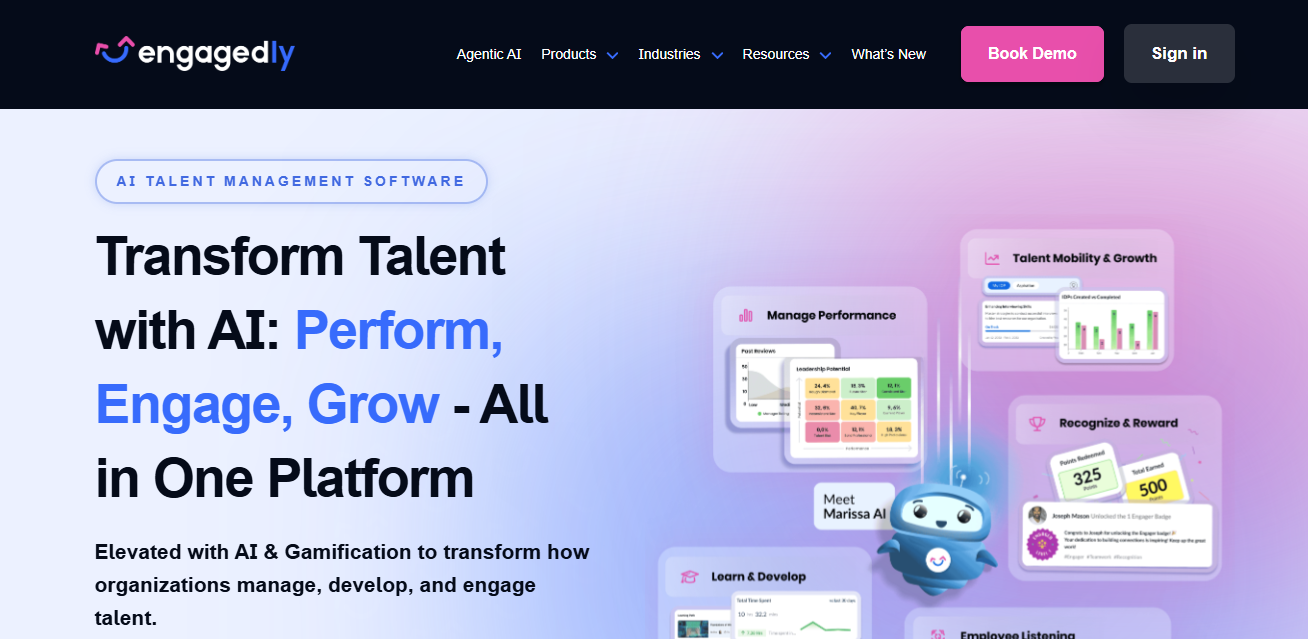
- Overview: Engagedly is an agile performance management and development solution that offers managers and employees a simpler way to help them monitor and improve performance.
- Differentiators: It’s differentiated by how it exposes API-first proprietary AI engines. Marissa AI is best used for performance insights. Agentic AI is a great tool for career pathing throughout the employee experience stack.
- AI Features: Marissa AI provides context-sensitive actions during reviews and feedback, and Agentic AI creates development and internal mobility paths based on real-time data.
- Pros: Very modular and perfect for fast-growing businesses in multiple functions. Provides unique feedback on intra-connections with performance measures and learning. Great for HR teams looking for proactive intervention tools.
- Cons: Its robustness can be more than what smaller teams want. The execution might demand a hands-on approach to onboard and train to reach its full potential.
- Pricing: Custom pricing based on features and team size; must contact for a quote.
2. HireVue (AI for Smart Hiring Decisions)
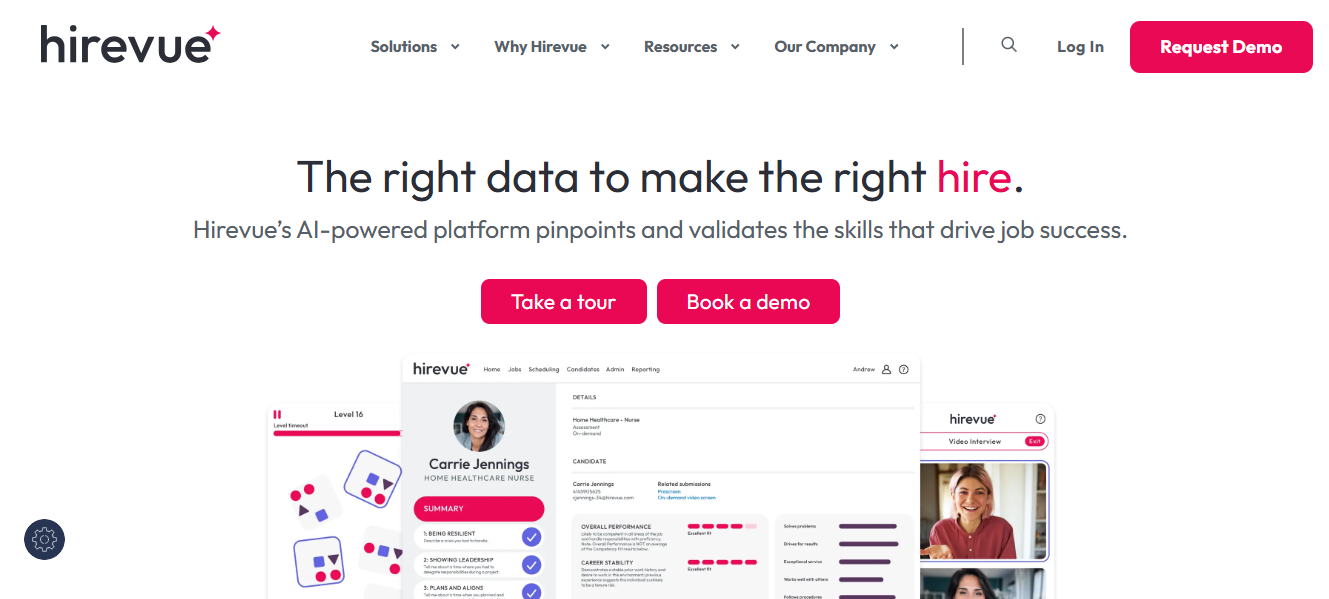
- Overview: HireVue is an AI-driven hiring platform that improves candidate evaluation in video-based interviews with data analysis, predictive analytics, and assessment tools.
- Differentiators: It leverages AI to analyze video interviews, evaluating verbal, facial, and linguistic cues to determine job performance and cultural fit.
- AI Features: It is a recruitment platform that analyses the tone, vocabulary, and expression in recorded interviews, combined with a list of structured questions. It helps make high-volume hiring more consistent.
- Pros: Ideal for organizations that hire extensively and conduct thousands of interviews. Slashes through recruiter complexities and makes the hiring process faster and more objective.
- Cons: Facial and tonal analysis based on AI can raise ethical concerns when transparency and auditability are lacking. There may be restrictions on customization without enterprise support.
- Pricing: Starts around $35 per recruiter per month; custom packages for larger teams.
3. Lattice (AI-Powered Performance and Engagement)
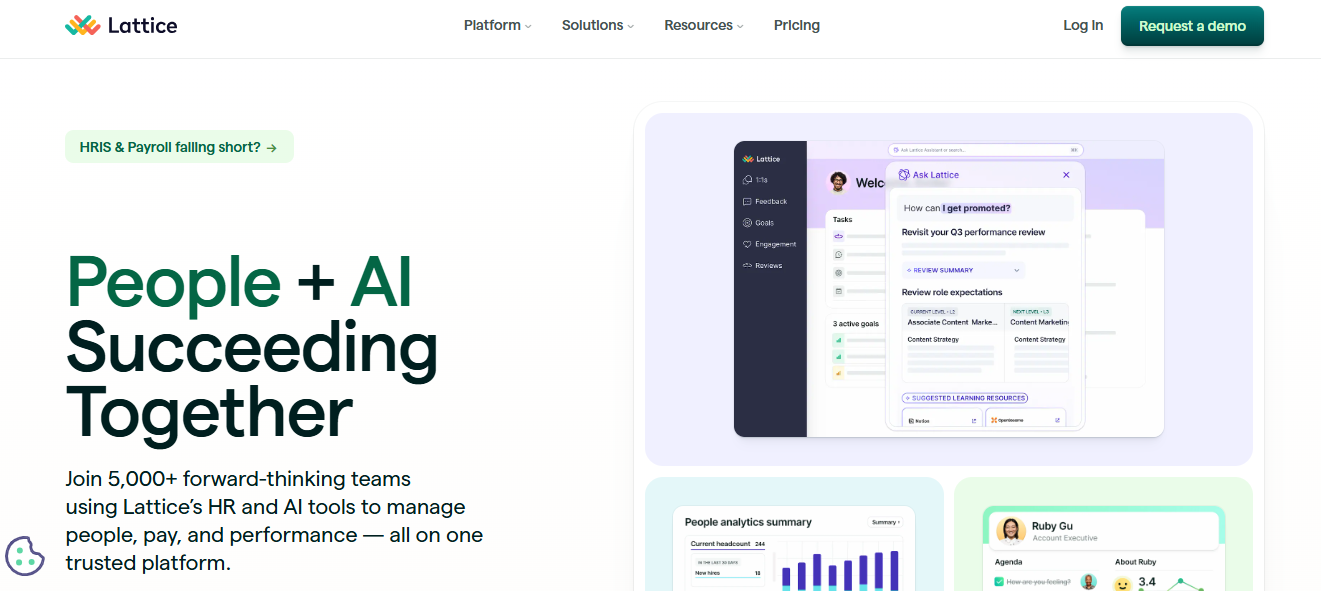
- Overview: Lattice is an easy-to-use, performance-first software that allows HR to manage employee development, growth, and engagement feedback.
- Differentiators: It incorporates artificial intelligence (AI) into its feedback and pulse survey systems to predict disengagement trends and burnout signs, allowing executives to take appropriate action in advance.
- AI Features: Lattice’s analytics derive information from peer feedback and manager reviews. HR departments can detect fluctuations in sentiment and drops in engagement.
- Pros: It’s extremely simple to use and loved by all. It’s modularly priced and best for a scaling team. Provides excellent engagement and goal-tracking tools.
- Cons: It doesn’t cover hiring or onboarding, so it wouldn’t work well on its own for small HR teams.
- Pricing: Begins at $11 per user/month after add-ons.
4. Effy AI (Easy Performance Reviews powered by AI)
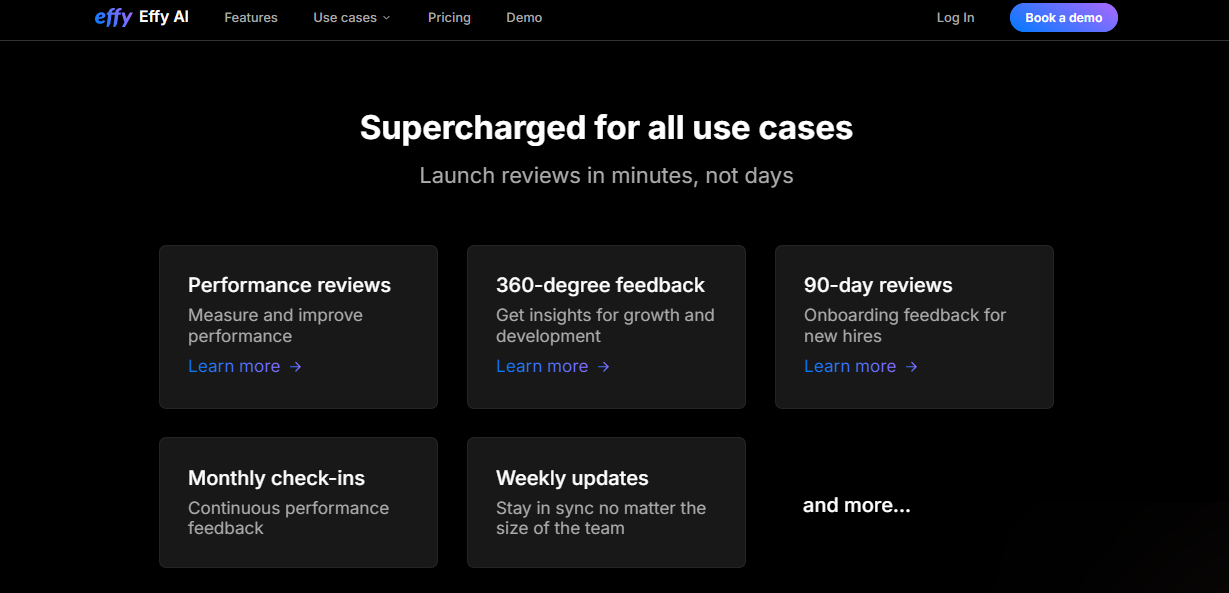
- Overview: Effy AI is purpose-built to simplify 360-degree performance and development feedback. It is well-equipped with AI-generated summaries, feedback prompts, and customized report templates.
- Differentiators: Its GPT-inspired prompts make it easy for users to create constructive, unbiased feedback, saving them up to 60% of the time they would otherwise waste on reviews.
- AI Features: It utilizes AI to sift through written feedback, suggest wording for responses, and compile summarized reviews for each employee to ensure quality and consistency.
- Pros: Quick installation and easy to learn. Solid initialization for startups and mid-sized teams in need of thorough reviews without the burden of full HR systems.
- Cons: No modules for onboarding, analytics, or L&D; limited in scale and scope; and its integrations are not flexible with other systems.
- Pricing: Basic plan is free; paid options start at $4 per user per month.
5. Visier (Workforce Intelligence at Scale)
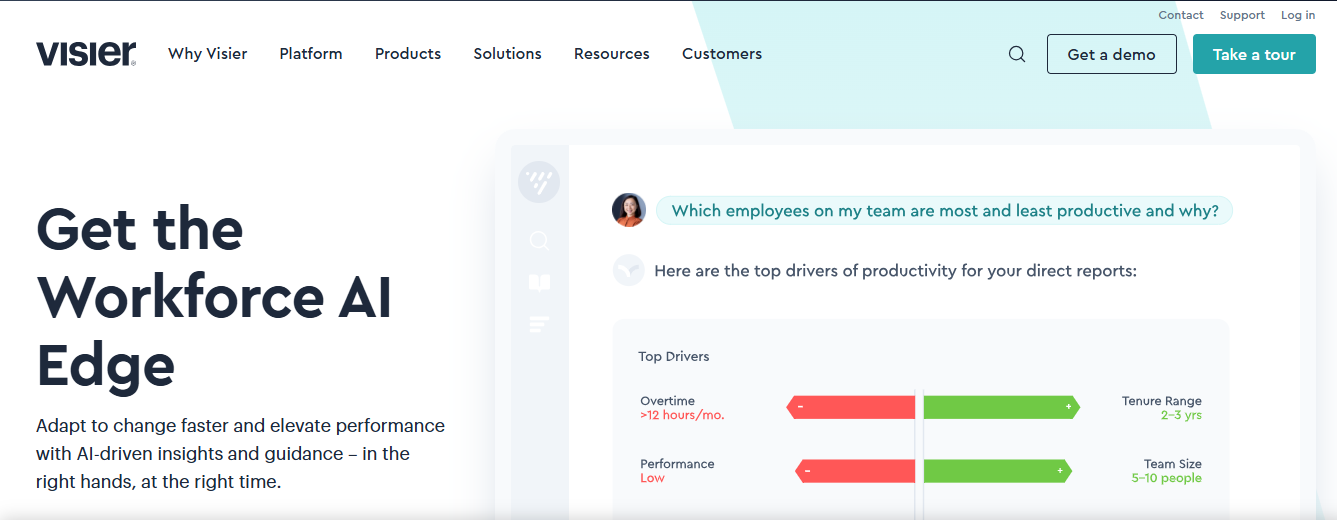
- Overview: Visier is a data analytics software that believes that data should be structured, well-understood, and become the focus of everything HR teams do.
- Differentiators: It pulls data from multiple sources within HR tech stacks, including ATS, payroll, and LMS. This empowers leaders to build a unified, decision-ready analytics ecosystem.
- AI Features: By using predictive modeling and dashboard alerts, its AI identifies workforce trends such as flight risk, pay inequity, and hiring pipeline bottlenecks.
- Pros: Ideal for large businesses with sophisticated reporting requirements. Very informative and helps plan for HR’s future.
- Cons: A steep learning curve, especially for teams that lack data expertise. Its implementation may need analysts or consultants.
- Pricing: Enterprise pricing; contact us for more details and a customized proposal.
6. Eightfold AI (The Talent Intelligence Platform)
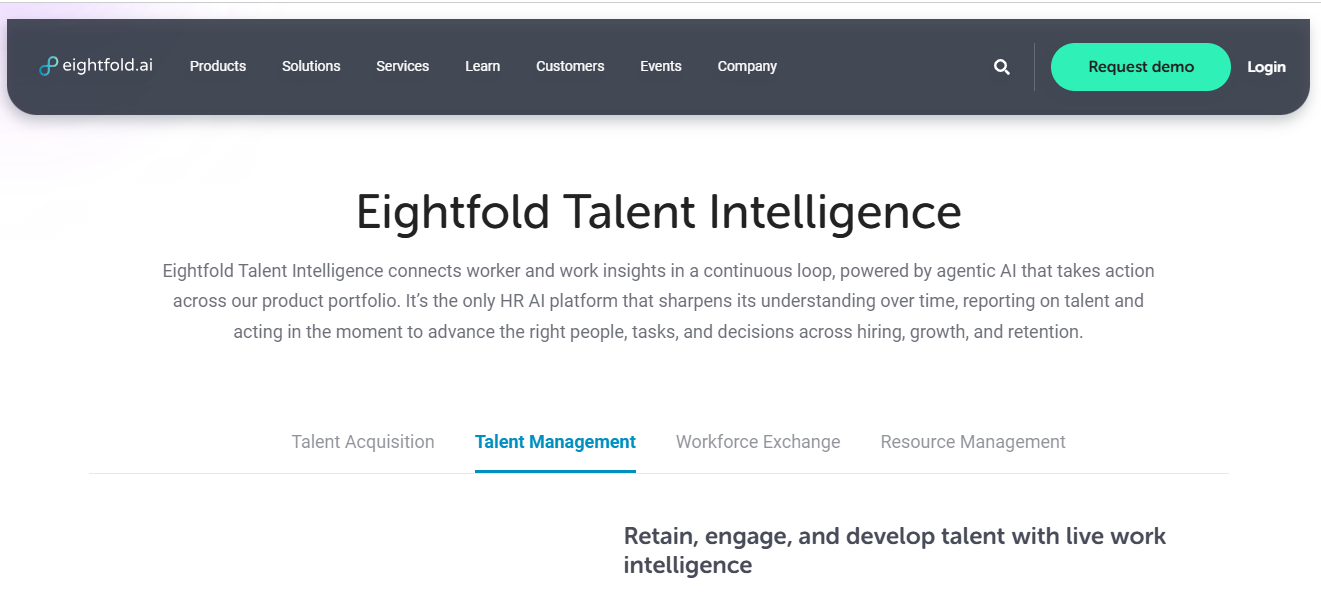
- Overview: Eightfold AI is a next-generation talent intelligence platform that leverages deep learning to match talent with opportunities like external hiring and internal mobility processes.
- Differentiators: It provides a skills-first approach that uses AI to pair candidates with roles they may not have applied for, driving diversity and performance.
- AI Features: From reading resumes and connecting future-fit roles to reskilling opportunities, its AI manages job matching, succession planning, and DEI mapping.
- Pros: Ideal for multinational companies aiming for agility, upskilling, and future-proofing their workforce. Nothing beats diversity and defense in depth.
- Cons: Pricing and complexity make it unrealistic for startups or lean HR teams to consider it. Organizations need stringent collaboration between IT and HR before implementing it.
- Pricing: Pricing is customized and conducted through consultation and a demo of the product.
7. Workhuman (AI and Employee Rewarding and Retention)
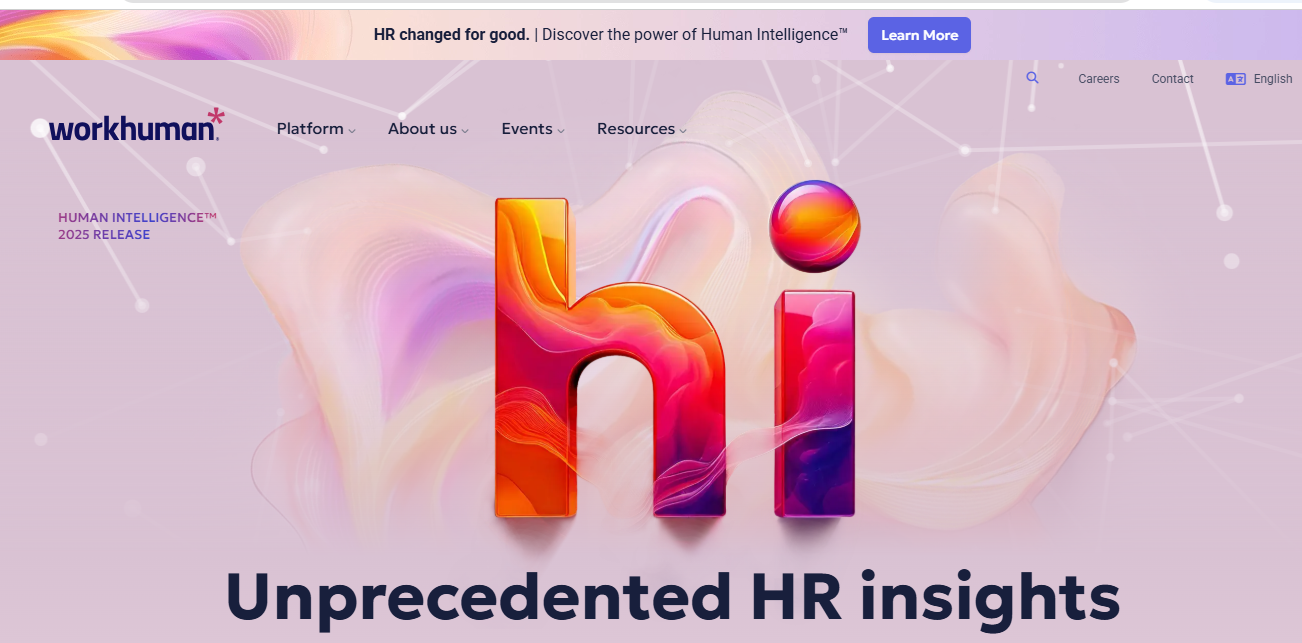
- Overview: Workhuman combines AI with employee experience strategy, recognition, culture analytics, and emotional intelligence to help drive retention.
- Differentiators: It transforms recognition data, who is being appreciated, by whom, and how often. This means predictive insights about engagement and flight risk.
- AI Features: AI-based tools facilitate peer recognition, DEIB participation, and reward data analysis at scale, driving company culture and reducing attrition.
- Pros: Great for organizations that emphasize corporate culture and diversity helping them build a strong culture.
- Cons: It is not a full-suite HR tool. It works best when integrated with existing HRIS or performance systems.
- Pricing: Customized according to the organization’s size and deployment requirements.
Wrapping Up
Manual HR management has evolved into an AI-informed talent strategy, reflecting how companies engage with their employees. These digital improvements enable HR leaders to evolve their roles from being reactive responders to predictive mentors.
What is so compelling about the top HR software using AI reviewed is not just that they are automation-enabled but also how they have been designed in a smart way to interconnect data points across the employee lifecycle.
Among the top tools, Engagedly supports businesses with integrated solutions for performance, development, and engagement.
However, the right platform for your organization ultimately depends on addressing its specific challenges and goals.
Book a demo now to learn more!
FAQs
How does HR software facilitate employee engagement?
Top HR Software using AI boosts engagement by constantly tracking employee sentiment, collecting feedback in real time, and prompting proactive nudges. With learning paths, recognition, and burnout detection, these platforms can also make employees feel heard, recognized, and supported.
What should you look for in the best AI-based HR software?
Seek a platform that includes predictive people analytics, AI-driven performance management, personalized L&D recommendations, automated recognition flows, and agentic intelligence capable of encouraging proactive action.
What is the best HR software for small-budget companies?
Effy is ideal for quick, easy reviews without overwhelming complexity, while Lattice offers excellent engagement tracking and performance insights at a low entry price.
Top 10 15Five Alternatives You Need to Know in 2025
Performance management tools play a pivotal role in enhancing employee performance and overall organizational productivity. These tools facilitate continuous feedback, goal setting, performance reviews, and employee engagement, which are crucial for maintaining a motivated and high-performing workforce. By implementing robust performance management systems, companies can align individual objectives with organizational goals, identify and address performance gaps, and foster a culture of continuous improvement and development.
Why Companies Might Seek Alternatives to 15Five
While 15Five is a widely recognized performance management tool known for its user-friendly interface and comprehensive features, companies might seek alternatives for several reasons. Some organizations may find that 15Five’s features do not fully align with their specific needs or industry requirements. Others may be looking for a more cost-effective solution, better integration capabilities with existing systems, or advanced analytics and reporting functionalities. Additionally, as the market for performance management tools evolves, new players with innovative features and unique approaches continue to emerge, offering competitive alternatives to established solutions like 15Five.
This article aims to provide an overview of the best alternatives to 15Five, helping companies identify the right performance management tool that meets their unique needs. We will evaluate each alternative based on key criteria such as features, pricing, user experience, and unique selling points, ensuring a comprehensive analysis to aid in the decision-making process.
Criteria for Evaluation
Features
Key functionalities are essential in performance management tools to ensure they meet the diverse needs of an organization. Important features include:
- Performance Reviews: Regular and systematic assessments of employee performance.
- Goal Setting and Tracking: Tools for setting, monitoring, and achieving individual and team goals.
- Feedback Mechanisms: Continuous feedback options to facilitate communication between employees and managers.
- Employee Engagement: Features that promote engagement and monitor employee satisfaction.
- Analytics and Reporting: Advanced reporting tools to analyze performance data and make informed decisions.
- Integration Capabilities: Ability to seamlessly integrate with other HR and productivity tools.
User Experience
Ease of use and user interface are vital for ensuring widespread adoption and effective utilization of the tool. Key aspects include:
- Intuitive Design: User-friendly interface that simplifies navigation and reduces the learning curve.
- Accessibility: Availability of mobile and web applications for easy access.
- Customization: Ability to tailor the tool to meet specific organizational needs and preferences.
- Support and Training: Availability of customer support, training resources, and documentation.
Unique Selling Points (USPs)
What sets each alternative apart from the competition is crucial in identifying the right fit for an organization. USPs might include:
- Innovative Features: Unique functionalities that address specific challenges or provide distinct advantages.
- Market Position: Reputation and credibility in the performance management space.
- Customer Reviews: Positive feedback and testimonials from existing users.
- Differentiation: How the tool stands out in terms of technology, approach, or user experience.
By evaluating 15Five alternatives based on these criteria, this article aims to provide a clear and comprehensive guide to help organizations choose the most suitable performance management tool for their needs.
Top 10 Excellent Alternatives to 15Five You Should Consider
Here are 10 excellent alternatives to 15Five to consider before choosing performance management software:
1. Engagedly
2. Lattice
3. Betterworks
4. Culture Amp
5. Reflektive
6. Leapsome
7. 7Geese
8. Trakstar
9. Zoho People
10. BambooHR
1. Engagedly
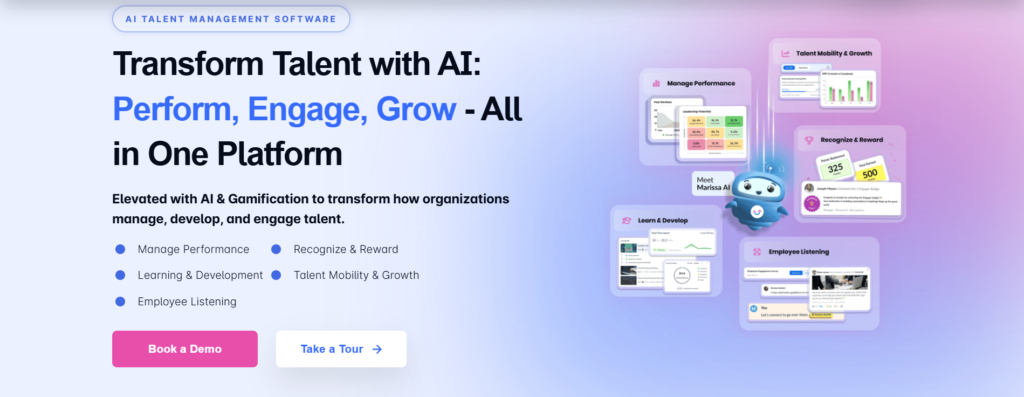
Engagedly is an AI-powered talent management platform designed to address every facet of workforce development, empowering organizations to solve persistent challenges with intelligent precision. Powered by Marissa, our AI SuperAgent, Engagedly helps mid-market organizations overcome hurdles like inconsistent performance evaluations, goal misalignment, low engagement, and fragmented learning experiences—transforming these challenges into opportunities for growth.
AI-Driven Capabilities
Engagedly unifies performance management, employee engagement, and learning management into a single, agentic platform. With Marissa’s intelligent guidance, organizations gain actionable insights and proactive recommendations that optimize performance and foster a culture of continuous improvement.
Key Features with Marissa AI
- Performance Reviews: AI-driven evaluations ensure consistent, unbiased, and transparent reviews, helping mid-market organizations improve satisfaction and retention.
- Goal Setting & Alignment: Marissa auto-suggests goals, aligns them with strategic objectives, and tracks progress in real time.
- Employee Engagement: AI-powered sentiment analysis and recommendations help leaders boost morale and reduce turnover by addressing engagement gaps.
- Continuous Feedback: Intelligent nudges foster a feedback-rich environment, empowering managers and employees to communicate effectively and grow together.
- Learning Management: Personalized learning paths, curated by AI, make upskilling efficient and engaging without the need for separate platforms.
- 360-Degree Feedback: AI-enhanced analytics provide deeper insights into peer, manager, and report feedback for holistic performance development.
- OKRs (Objectives and Key Results): Automated tracking and predictive analytics keep teams aligned and on track to meet organizational goals.
- Employee Recognition: AI identifies top performers and suggests timely recognition opportunities, fostering motivation and a culture of appreciation.
User Experience
Engagedly delivers a seamless experience across web and mobile with an intuitive design and AI-guided navigation. Marissa’s conversational interface allows leaders and employees to interact naturally—no complex menus, just strategic conversations that turn intent into intelligent actions.
Unique Value Proposition
Engagedly isn’t just another HR system—it’s an Agentic AI-driven talent management powerhouse. By combining Marissa’s intelligence with robust tools, mid-market organizations can:
- Automate tactical processes so leaders can focus on strategy.
- Gain predictive insights to proactively address workforce challenges.
- Build a culture of engagement, growth, and high performance.
For organizations seeking scalable talent transformation, Engagedly with Marissa is not just an upgrade—it’s a competitive advantage.
2. Lattice

Lattice is a performance management and employee engagement platform that focuses on continuous feedback and employee development. It helps organizations drive better performance through goal setting, performance reviews, and engagement surveys.
Key Features:
- Performance Reviews: Structured performance evaluations to assess and develop employee performance.
- OKRs: Tools for setting and tracking objectives and key results.
- Feedback: Continuous feedback options to facilitate regular communication between employees and managers.
- Employee Engagement Surveys: Tools to measure and improve employee engagement and satisfaction.
User Experience:
Lattice is known for its intuitive interface and robust analytics, making it easy for users to navigate and gain insights. The platform’s design focuses on simplicity and effectiveness, ensuring a positive user experience.
USP:
Lattice’s strong focus on employee development and continuous feedback sets it apart, making it an excellent choice for organizations that prioritize ongoing employee growth and improvement.
3. Betterworks

Betterworks is a performance management platform that emphasizes goal alignment and achievement. It provides tools for setting and tracking goals, conducting performance reviews, and facilitating continuous performance management.
Key Features:
- Goal Setting and Tracking: Tools to set, monitor, and achieve individual and organizational goals.
- Performance Reviews: Comprehensive performance evaluation tools.
- Feedback: Continuous feedback mechanisms to support employee development.
- Continuous Performance Management: Tools to ensure ongoing performance tracking and improvement.
User Experience:
Betterworks features a clean and user-friendly interface that integrates seamlessly with other tools. Its design focuses on ease of use, ensuring a smooth user experience.
USP:
Betterworks stands out for its emphasis on goal alignment and achievement, helping organizations ensure that their employees’ goals are aligned with overall business objectives.
4. Culture Amp

Culture Amp is an employee engagement and performance management platform that provides data-driven insights to improve company culture. It offers tools for engagement surveys, performance reviews, goal setting, and feedback.
Key Features:
- Employee Engagement Surveys: Tools to measure and enhance employee engagement.
- Performance Reviews: Comprehensive tools for conducting performance evaluations.
- Goal Setting: Facilitates setting and tracking individual and team goals.
- Feedback: Continuous feedback mechanisms to support employee development.
User Experience:
Culture Amp features a user-friendly design that provides actionable insights, making it easy for users to navigate and make informed decisions.
USP:
Culture Amp’s data-driven insights for improving company culture make it a valuable tool for organizations looking to enhance employee engagement and performance through actionable data.
5. Reflektive

Reflektive is a performance management platform that focuses on real-time feedback and goal management. It provides tools for performance reviews, goal setting, feedback, and check-ins to drive continuous improvement.
Key Features:
- Performance Reviews: Structured tools for conducting regular performance evaluations.
- Goal Management: Tools for setting and tracking individual and team goals.
- Feedback: Real-time feedback mechanisms to facilitate regular communication and development.
- Check-Ins: Regular check-ins to monitor progress and address any issues promptly.
User Experience:
Reflektive features a modern and intuitive interface that ensures ease of use. The platform’s design focuses on simplicity and effectiveness, providing a positive user experience.
USP:
Reflektive’s real-time feedback and goal management capabilities set it apart, making it a valuable tool for organizations that prioritize continuous improvement and timely feedback.
6. Leapsome

Leapsome is a comprehensive performance management and learning platform designed to enhance employee development and organizational performance. It integrates various functionalities to provide a seamless experience for managing performance reviews, goal setting, and continuous feedback.
Key Features:
- Performance Reviews: Structured and customizable performance review processes.
- Goal Setting: Tools for setting, tracking, and achieving individual and team goals.
- Feedback: Continuous feedback mechanisms to foster ongoing development and communication.
- Learning Management: Integrated learning management system to support employee training and development.
User Experience:
Leapsome features an intuitive platform with customizable workflows, making it easy for users to tailor the system to their specific needs. The user-friendly interface ensures a smooth experience for both employees and managers.
USP:
Leapsome stands out for its integration of performance management and learning, providing a holistic approach to employee development and organizational growth.
7. 7Geese

7Geese is a performance management platform that focuses on OKR-driven performance management. It provides tools for setting and tracking Objectives and Key Results (OKRs), conducting performance reviews, and facilitating feedback and recognition.
Key Features:
- OKRs: Tools for setting, tracking, and achieving Objectives and Key Results.
- Performance Reviews: Comprehensive performance evaluation tools.
- Feedback: Continuous feedback mechanisms to support employee development.
- Recognition: Features to recognize and reward employee achievements.
User Experience:
7Geese features a clean interface with easy navigation, ensuring a positive user experience. The platform is designed to simplify the performance management process and enhance user engagement.
USP:
7Geese’s strong focus on OKR-driven performance management sets it apart, making it an excellent choice for organizations that prioritize goal alignment and achievement.
8. Trakstar

Trakstar is a performance management platform that provides tools for performance reviews, goal setting, feedback, and employee engagement. It aims to enhance organizational performance through comprehensive reporting and analytics.
Key Features:
- Performance Reviews: Tools for conducting regular and structured performance evaluations.
- Goal Setting: Features to set, track, and achieve individual and team goals.
- Feedback: Continuous feedback mechanisms to facilitate communication and development.
- Employee Engagement: Tools to measure and improve employee engagement.
User Experience:
Trakstar features a simple and effective design, making it easy to navigate and use. The platform provides comprehensive reporting and analytics to support informed decision-making.
USP:
Trakstar’s extensive reporting and analytics capabilities make it a valuable tool for organizations seeking in-depth insights into their performance management processes.
9. Zoho People

Zoho People is a comprehensive HR management platform that includes performance management features. It integrates seamlessly with other Zoho products, providing a unified solution for managing HR and performance processes.
Key Features:
- Performance Reviews: Tools for conducting regular performance evaluations.
- Goal Setting: Features to set, track, and achieve goals.
- Feedback: Continuous feedback mechanisms to support employee development.
- HR Management: Comprehensive HR management features, including employee data management, leave tracking, and more.
User Experience:
Zoho People provides a user-friendly interface that integrates with other Zoho products, ensuring a seamless experience for users. The platform’s design focuses on ease of use and efficiency.
USP:
Zoho People’s comprehensive HR suite with integrated performance management features makes it a versatile solution for organizations seeking a unified HR and performance management platform.
10. BambooHR

BambooHR is an all-in-one HR management platform that includes performance management features. It provides tools for performance reviews, feedback, goal setting, and employee data management.
Key Features:
- Performance Reviews: Structured tools for conducting performance evaluations.
- Feedback: Continuous feedback mechanisms to support employee development.
- Goal Setting: Features to set, track, and achieve individual and team goals.
- Employee Data Management: Comprehensive tools for managing employee data, leave tracking, and more.
User Experience:
BambooHR features an easy-to-use interface that simplifies HR and performance management processes. The platform is designed to be intuitive and accessible, ensuring a positive user experience.
USP:
BambooHR’s all-in-one HR and performance management platform makes it a valuable tool for organizations looking for a comprehensive solution to manage their HR and performance processes.
Conclusion
Performance management platforms offer a wide spectrum of options, each catering to diverse organizational needs and preferences. From tools emphasizing advanced analytics and seamless integration capabilities to those focusing on real-time feedback, goal alignment, or comprehensive employee engagement, the choices are plentiful. By carefully evaluating these alternatives based on criteria such as functionality, user experience, and innovative features, companies can select a platform that best supports their unique goals and operational dynamics. This strategic decision not only enhances organizational effectiveness but also fosters a culture of continuous improvement and employee development, driving sustained success in today’s competitive landscape.

Employee Happiness: 14 Ways To Keep Employees Happy
Keeping employees happy at work should be a top priority for any company. While success metrics like profits and productivity are crucial for business growth, employee happiness and satisfaction are what will help ensure long-term, sustainable success. When people enjoy where they spend the majority of their waking hours each day, they will naturally be more engaged, motivated, and committed to their work.
This positive psychological state and environment leads to numerous tangible benefits for the company as well, such as increased retention rates, fewer sick days taken, higher quality and productivity of work, and even fewer safety incidents.
By focusing on employee well-being and empowerment, management can build high morale and loyalty within their workforce, which will translate directly into a competitive advantage. This article will explore 14 actionable ways that companies can genuinely improve employee happiness and engagement.
What Is Employee Happiness in 2025?
Employee happiness is more than a feel-good metric—it’s a multi-dimensional state encompassing satisfaction, emotional well-being, purpose, and a sense of belonging within your workplace.
In 2025, this includes:
- Work-life balance flexibility – From four-day workweeks to remote/hybrid options, employees expect autonomy in managing their time. Dubai’s four-day workweek pilot saw significant gains in both happiness and productivity.
- Well-being tools embedded in workflows – Mental health check-ins, mindfulness breaks, and digital wellness integrations are now part of daily work platforms.
- Emotional well-being alignment – Positive emotions like enthusiasm, gratitude, and purpose are recognized as major drivers of performance, loyalty, and innovation.
Why Employee Happiness Will Shape Success in 2025
Productivity & Innovation – Happier employees are more helpful, creative, and high-performing. A Massey University study found increased innovation among staff reporting high happiness levels.
Business Performance & Well-being – Companies with high well-being scores (as tracked by Indeed and Oxford) have consistently outperformed major stock indices like the S&P 500 and Nasdaq.
Engagement & Economic Impact – Fully engaged, happy workforces could add $9.6 trillion to the global economy annually.
Inclusion Enhances Happiness – Inclusive workplaces increase employee satisfaction by 32% and overall wellness by 43%.
Autonomy & Retention – 83% of workers now prioritize work-life balance over higher pay. Flexible models are not perks—they’re a core requirement.
The Cost of Unhappiness – Only 23% of employees worldwide are highly engaged, representing a huge opportunity gap for businesses.
What is Employee Happiness?
Employee happiness involves maintaining a positive outlook at work, being open to solving challenges, accepting constructive feedback, and consistently striving for personal improvement without feeling overwhelmed. Content employees find joy in their work, exhibit high levels of engagement, and experience satisfaction in their jobs.
Also Read: 4 Ways to get away from work on weekends
According to Sonja Lyubomirsky’s ‘The How Of Happiness’, 50% of happiness is genetically predetermined, while 10% is due to circumstances in life (Family, health, etc.) and 40% is the result of your outlook.
As an employer, you cannot do anything about the first two but the last 40% of happiness is something you can help your employees with. Analyzing what makes employees happy is quite difficult, but it is more difficult to change the structure of your daily work pattern and prioritize employee happiness.
Why Keeping Employees Happy Is More Critical in 2025
In a rapidly shifting workplace, happiness is no longer optional—it’s central to performance, retention, and cultural resilience.
- Hybrid Work Expectations – A staggering 83% of employees now value work-life balance over salary, making flexible arrangements a key pillar of workplace happiness.
- Trust and Empowerment Matter More than Pay – Success stories from companies like TAG Live and The Savoy show that trust—via autonomy and recognition—delivers significantly more satisfaction than compensation alone.
- Genuine Happiness Outshines Perks – Deep employee happiness stems from meaningful, fulfilling work—not just pay or status. Roles in caregiving or creative fields often yield deeper satisfaction.
Proven Strategies to Keep Employees Happy
Flexible Work & Clear Boundaries – Flexible schedules and clear workload expectations help employees recharge and remain productive.
Create a Corporate Happiness Plan – Integrate happiness into company strategy to ensure consistent, meaningful action across the organization.
Use the Care–Connect–Coach–Contribute–Congratulate Framework – A simple but powerful method to build trust, engagement, and recognition.
Career Development as a Happiness Driver – Offer structured growth and progression opportunities that bring pride, empowerment, and a sense of purpose.
Prioritize Well-Being & Mental Health Support – Mindfulness training, wellness stipends, and EAPs show strong ROI in engagement and retention.
Build Connection in Hybrid Teams – Regular check-ins, virtual coffee breaks, and shared rituals to reinforce belonging.
Employee Happiness in the Workplace: 14 Ways to Keep Employees Happy
We all know that improving employee satisfaction leads to a better atmosphere at the workplace and makes teamwork effortless. But it is not easy for an employer to suddenly change their perspective and work towards individual employee’s happiness.
So instead of struggling to change your work environment drastically, here’s a list of things that you can initially start fixing at your workplace to keep your employees happy.
1. Allow Employees To Voice Their Opinions
Most employees feel dissatisfied with their jobs because their opinions are often not valued. This behavior leads to the disengagement of employees at the workplace, eventually leading to dissatisfaction at work. Give your employees a chance to express what they feel and allow them to contribute their ideas at work.
2. Recognize Their Good Work
Employees feel dissatisfied with their work when they feel like their work is not appreciated. Appreciation is the key to keeping employees motivated and engaged. Recognize the efforts of your employees and reward them. Reward doesn’t always mean money, because money is a short-term motivator. Many other things can be used as rewards to recognize good work.
3. Provide Training And Resources
Training employees and providing them with the necessary resources makes them feel that their company is invested in them. The employees who receive training are usually better satisfied and are more motivated than their counterparts who do not receive frequent training.
Continuous training or learning directly affects organizational growth because of the changing economy.
Also Read: Top 5 Reasons To Have A Learning Management System In The Workplace
4. Don’t Shift Priorities
Another important factor that makes employees feel unhappy is inconsistent priorities.
Does the line “drop everything and do this right now” sound familiar? Bad managers use it very often and it is quite irritating for their employees to understand why the task is so important that it disrupts their daily work pattern. If you want employees to prioritize certain tasks over others, then you need to communicate why. It is easier to disrupt your routine or shift priorities when you know why exactly you need to do so.
5. Communicate Frequently
Another big problem that plagues workplaces these days is poor communication. When managers are not able to communicate with their staff, it leads to a whole host of problems.
Imagine an employer, not being able to communicate company goals with their employees properly. The first ones to be affected by this behavior are the employees. Employees feel happy and motivated to work only if their goals and responsibilities are communicated to them. And this is just a small example. A lack of communication can seriously affect engagement, and productivity and kill morale.
Communication does not always come easy. But it is something that becomes easier to do, over time. All managers need to do is start the conversation.
Also Read: Employee Motivation Is Not About Perks Alone
6. Flexible Working Schedules
After a long wait of two years, employers are now getting a chance to call their employees back to offices. But is everyone interested in starting to work from the office? As per the research, 68% of US employees still want to work from the comfort of their home. Some employees are even thinking of changing jobs if they are not offered remote work. The data shows the reluctance among employees to get back to the usual work environment. In such a case, it is better to offer flexible work schedules to employees to keep them happy and committed to work.
7. Promote Work-Life Balance
Encouraging work-life balance goes beyond offering flexible work hours, paid time off, and family-friendly policies. Employers can actively promote work-life balance by discouraging overtime and encouraging employees to take regular breaks and vacations. Implementing remote work options and providing access to wellness programs, fitness facilities, or stress-reduction activities can also contribute to a healthier work-life balance.
8. Provide Opportunities for Growth
To foster continuous growth and development, organizations can offer not only career development opportunities but also mentorship programs and cross-functional training. Investing in employee skill development through workshops, conferences, and online courses can empower employees to take charge of their own career paths, leading to higher job satisfaction and loyalty.
9. Foster a Positive Work Environment
Creating a positive work environment involves more than just organizing team-building activities and social events. Employers can actively involve employees in decision-making processes, seek their feedback, and address any concerns promptly. Nurturing a culture of inclusivity and diversity can enhance employee engagement and create a sense of belonging within the workplace.
10. Implement Employee Wellness Programs
Besides traditional wellness programs, employers can consider promoting mental health resources, stress management workshops, and employee assistance programs. Encouraging physical activity through fitness challenges, ergonomic workspaces, and subsidized gym memberships can boost overall well-being and reduce healthcare costs for the organization.
11. Provide Competitive Compensation
Offering competitive salaries is essential, but employers can also consider additional incentives like performance-based bonuses, profit-sharing, or stock options. Moreover, non-monetary benefits such as flexible spending accounts, retirement plans, and comprehensive health insurance packages can enhance the overall compensation package.
12. Encourage Open Communication
Establishing an open communication culture involves actively seeking feedback from employees through surveys, suggestion boxes, or regular one-on-one meetings with managers. Responding to employee concerns, providing updates on company developments, and communicating clear expectations can create a transparent and trusting work environment.
13. Recognize and Celebrate Achievements
While regular recognition is essential, employers can enhance the impact by providing personalized recognition and acknowledgment of employees’ accomplishments. Celebrate milestones, work anniversaries, and major achievements publicly, both within the team and across the organization. Consider offering tangible rewards, such as gifts, certificates, or special privileges, to showcase genuine appreciation.
14. Reward Employee Loyalty
Acknowledge and appreciate long-term commitment by implementing programs that specifically recognize employee loyalty. Consider milestone celebrations, personalized recognitions, and exclusive benefits for those who have dedicated significant time to the organization. Recognizing and rewarding loyalty fosters a sense of belonging and motivates employees to continue contributing to the company’s success.
It is important to remember, that at the end of the day, managers cannot magically make employees happy. Happiness is a very individual concept and managers cannot fix all problems. Managers can try to make employees happy and lead the way, but ultimately, it is not the responsibility of the manager and the entire burden of employee happiness should not rest on their shoulders.
2025 Trends Shaping Employee Happiness
Purpose-driven Recognition – Recognition tied to company values and community impact drives deeper satisfaction.
Hybrid Flexibility as a Norm – Flexible schedules and location choice are now baseline expectations.
AI & Well-being Support – AI is increasingly being used to provide mental health nudges, detect burnout signals, and offer personalized well-being resources.
Human-Centric AI Design – AI must enhance rather than replace human connection to maintain trust and morale.
Frequently Asked Questions
Q1. Does employee happiness have an impact on productivity?
Ans. Employee happiness has a direct impact on the productivity of employees. Multiple research studies have shown that happy employees can produce better results, are committed to organizational goals, stay longer in the organization, and offer more support to businesses in difficult times.
Q2. How to measure employee happiness?
Ans. The following ways help measure employee happiness: conducting an employee happiness survey, having authentic conversations, measuring the employee happiness index, and productivity index, focusing on employee wellness, and conducting anonymous surveys.
Q3. What are some ways to keep employees happy?
Ans. You can use the following ways to keep employees happy:
- Allow employees to voice their opinions
- Recognize employees frequently
- Offer learning and development opportunities
- Provide a flexible working schedule
- Create an open and transparent company culture
The Impact Of Employee Engagement On Productivity
Employees who are engaged with their work and feel a sense of commitment to their employer are more productive. Their motivation goes beyond personal factors, making them more focused and driven than their disengaged colleagues. They are efficient and driven toward organizational success.
In this article, we will discuss the relationship between employee engagement and productivity and how they drive key business outcomes.
Continue reading “The Impact Of Employee Engagement On Productivity”Employee Data Management in 2025: Strategies, Best Practices & Tools for HR Success
Data is present throughout the employee cycle, from the data-driven recruitment phase to the employee exit interview. But how would you feel if we told you there’s a chance you’re missing vital information about your employees?
You may not know how many people moved over the last few years? Or if they have the right skills for the next big project you’re about to undertake. Maybe you don’t know enough about their expense reports.
When you handle massive amounts of employee data, it’s easy to lose sight of what’s essential for your organization and how to leverage it to move your company forward.
In today’s digital-first workplace, employee data management is no longer just about storing files—it’s about creating a reliable, real-time source of truth that supports business strategy, compliance, and employee experience. As organizations move into 2025, the stakes are higher: regulatory pressures are tightening, employees expect data transparency, and HR leaders need accurate insights to drive workforce planning.
This guide explores employee data management from its definition to 2025 innovations, essential tools, best practices, and actionable templates so your HR team can stay ahead.
What Is Employee Data Management?
Employee data management involves collecting, storing, and maintaining critical information concerning your organization’s employees.
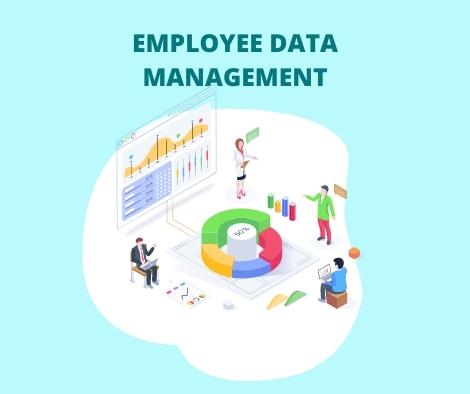
From personal bios and medical information right down to employment details and performance data, collecting data from each employee is a fundamental HR requirement. But this operational need of maintaining and managing the information collected at onboarding, during employment, and throughout their tenure from employees is an arduous task.
Why? Employee data can be required for statutory purposes and, therefore, must be maintained for long periods. If you don’t want to spend too much time and effort doing this, you need a master plan for collecting, organizing, and retaining all that data to comply with legal regulations.
What Is Employee Data Management in 2025?
Employee data management has evolved into a strategic, AI-powered process designed to capture, maintain, and leverage workforce information for smarter business decisions.
Key characteristics in 2025 include:
- Centralized digital records through HRIS or integrated HR platforms for clean, accessible, and real-time workforce insights.
- Automated accuracy that removes duplicates, updates outdated entries, and streamlines payroll, compliance, and analytics.
- Predictive analytics to forecast turnover, identify skill gaps, and optimize performance rewards.
What Is Employee Data Management in 2025?
Employee data management has evolved into a strategic, AI-powered process designed to capture, maintain, and leverage workforce information for smarter business decisions.
Key characteristics in 2025 include:
- Centralized digital records through HRIS or integrated HR platforms for clean, accessible, and real-time workforce insights.
- Automated accuracy that removes duplicates, updates outdated entries, and streamlines payroll, compliance, and analytics.
- Predictive analytics to forecast turnover, identify skill gaps, and optimize performance rewards.
Benefits of Employee Data Management
Employee data management can be challenging, but it’s especially essential in today’s data-driven company culture. The fact you get several significant benefits further sweetens the deal.
These are the benefits of effectively managing your employee data:
Creates a Comprehensive Picture of Your Workforce
Employee data management gives you a good understanding of:
- who works for you,
- how long they have worked,
- what skill sets they possess, and
- their overall work performance.
Knowing this information can help you accumulate your overall organization strategy and create a more productive work environment by assigning the right people to the right roles.
Saves Time
Correctly collecting and storing your employee’s information saves you time as you can easily access the data when needed without extra hassle.
Boosts Operational Efficiency
Employee data management makes your operations more efficient. You know what’s going on with your employees, what needs to be updated, and which HR processes need optimization to eliminate bottlenecks and ensure smooth working.
Identifies Human Capital Trends
Managing employee data also helps you spot trends related to your workforce. For instance, you may notice employees tend to leave your organization after a 2-year stay. After knowing this, you can focus on building programs aimed at improving staff retention.
Ensures Compliance
Data laws exist to ensure the safety of your sensitive documents and information. Incorporating these laws in your data management processes helps you maintain legal compliance and gives you greater peace of mind.
7 Types of Data to Store
It isn’t unusual to wonder what kinds of employee data impact your organization most. Here’s a list of the common data types you should store in your employee database:
Demographic Information
These are basic details about your employees. Think: their gender, age, marital status, educational qualifications, and nationality.
This data tells you what kind of people you have in your workforce, their general characteristics, and how diversified they are. Knowing this information always comes in handy, so ensure you store in an easily accessible place.
While you’re at it, limit the number of people that have access to demographic data as it’s still sensitive.
Medical Information
Medical data helps you maintain a safe workplace, so keeping and managing these data properly is essential. In fact, 87% of company leaders say they collect pandemic-related medical data, including vaccine status, COVID-19 tests, and temperature checks.
Similarly, you can also store your employees’ medical data, including drug tests, the Family and Medical Leave Act (FMLA)-related, and COVID-19-related information.
Employment Details
Employment details consist of records such as past work experiences, employment agreements, hiring incentives, background check results, and legal documents showing each individual’s employment terms.
Other information includes employee ID number, leave policies, and bank details for receiving salaries.
Job Details
No, job details and employment details aren’t the same.
Job details comprise job description, skills and expertise, current projects, and location. This information helps you identify employees who currently don’t have work assigned to them in existing projects and have the capacity to take on more tasks within the organization.
Make sure these details are updated annually, as well as when new projects come up.
Training and Skills Development Data
Employees need training and development to reach their full potential and gain the necessary skills to do their duties effectively. An example of such an activity is the sales training game, just one of many strategies to improve sales performance.
As these trainings occur periodically, it’s vital to accurately record the training each employee gets and what skill sets they have or need to have.
Doing this will help you maintain an inventory of employee skill sets and identify any skill gaps that require additional training. You can also decide which employees can take on more responsibilities like a managerial role.
Performance Data
Many organizations regularly evaluate their employees’ performance engagement through annual or quarterly performance appraisals.
Storing relevant HR metrics data helps you track your workers’ progress and gives you information like, say, the state of high-performing sales teams. You can then set goals and expectations for other employees in different departments of the company.
Keeping sales performance data also helps you brainstorm employee reward and recognition ideas for awards and achievements events.
Also Read: A complete guide to performance management
Employee Feedback Data
These include data from onboarding surveys, employee engagement surveys and templates, and exit interviews. The valuable information generated from the channels will allow you to make changes and improvements across your organization whenever necessary.
7 Best Practices and Tips for Effective Employee Data Management
Now that you know the kinds of data you need to store, let’s find out the best ways to manage it.
1. Assess and Audit the Data You Have
Carefully assess the data currently stored in your HR department. What kinds of data do you currently have, and how important are they for your organization?
You must understand the information on your employees, both past and present, so you know how to organize and store them. Certain records shouldn’t be kept for long, so it’s vital to determine when to delete them from your data management system.
2. Categorize Your Stored Data
It makes sense to separate the data you collected from your employees and then organize and store it.
Let us explain—suppose you have a large organization and find yourself responsible for handling massive amounts of data after interpreting employee engagement survey results.
How do you do it? The most effective way is to categorize the data by creating data segments, such as gender, location, and department.
Categorizing enables your HR department to easily access all employees information, saving precious time that would otherwise have been wasted scouring and locating scattered files. It also protects sensitive information by storing them separately from non-sensitive data.
3. Limit Access of Employee Data to Authorized Users
Certain employee details like medical records are confidential and should only be assessed by authorized users.
Create a structure that lets you define who should have access to such data. Passwords and multi-factor authentication may not be enough. In such cases, consider implementing policies that require approval from top-level management before getting access to any sensitive information.
4. Redesign Data Handling Methods
The first step to redesigning your data management is getting clarity on the existing laws on employee data storage. Follow this up by evaluating your current techniques for collecting, sorting, and processing employee information.
Always ask your employees for permission before storing their information and let them know the measures you have in place to protect it. This is especially important when you have sensitive information like medical records. Research shows only 1 in 4 employees feel comfortable giving out such information to their employer.
We also recommend referring to the employee data bill of rights document to better understand the appropriate way to handle employee data.
5. Use a Data Management Software
There’s hardly any room for error when managing employee data, which is why automation is the best.
A data management software keeps every bit of the employee information in one place, making it easy to handle and accessible. Don’t postpone using tech tools to track and store employee data quickly and efficiently wherever possible.
Also Read: Why you need a talent management software!
6. Encrypt All Employee Information
Data breaches resulting from cybercrimes can happen anytime, so it’s important to pay utmost attention to data security.
While it’s standard for organizations to only encrypt sensitive information, a better approach would be encrypting the whole employee file. If you update employee records regularly, ensure the HR department and high-level managers know how to keep it safe.
7. Train HR Staff to Handle Data Securely
The HR team and managers with access to employee data should be trained regularly on applicable laws, the outcome of data breaching, and bad data management.
If an employee resigns from the company, the managers need to be professionally prepared to prevent data leaks. Keep your team updated on the latest employment laws to ensure legal compliance on data storage.
Managing Employee Data Properly Is Serious Business
Employee data management facilitates strategic human resource management.
When handling information about your employees, figure out the types of data your organization needs and use automation tools like Engagedly to collect, manage and analyze it for good purpose. Always keep data security and compliance with data laws top of mind, too.
It’s better to be overly protective of your employees’ information than be casual. Use the tips above to effectively manage and protect your employee data.
Conclusion
As HR moves deeper into the digital transformation era, employee data management is emerging as the foundation for strategic workforce decisions, compliance assurance, and employee trust. By adopting AI-enabled tools, following best practices, and keeping data governance transparent, organizations can not only improve operational efficiency but also create a work culture grounded in accuracy, fairness, and innovation.
Employee Data Management FAQs
Q1: What’s the first step toward improving employee data management?
Start with a clean HRIS or single source of truth. Build governance and automate updates.
Q2: How can data management boost performance reviews?
Accurate, accessible data allows HR to track goals, engagement, and training outcomes more effectively.
Q3: How do we balance data use with employee privacy?
Implement clear policies, limit access based on roles, ensure transparency, and secure all systems.
This article is written by Rana Bano. She is a one-part B2B content writer and one-part content strategist. She uses these parts to help SaaS brands tell their story, aiming to encourage user engagement and drive traffic.
Benefits of Implementing an Employee Career Development Program
Lack of career development is one of the most compelling reasons employees quit their jobs. Experts find that employees working without a clear chance of career progression are more likely to experience burnout. Once this phenomenon happens, it is common for their motivation for work and quality of service to plummet.
Employers and other company stakeholders should worry about burnout and how the lack of employee career development creates this problem. After all, losing employees too often is expensive and potentially debilitating to organizational operations. For this reason, companies should cautiously invest in competitive career development programs.
What Are the Benefits of Career Development in 2025?
In 2025, the benefits of career development extend far beyond individual growth—they’ve become strategic organizational assets. Companies that prioritize career growth aren’t just building skills; they’re shaping resilient, future-ready workforces.
Key advantages include:
- Job satisfaction, engagement, and retention – Employees are more likely to stay when they see clear growth pathways and receive regular development opportunities. Research by WorkL shows that Best Places to Work achieve ~12% higher career development ratings alongside improved loyalty and output.
- Profitability and retention – Organizations investing in career planning enjoy 11% greater profitability and double the retention of high performers.
- Growth mindset and future-readiness – Personalized, AI-enhanced learning aligned with employee goals increases motivation and efficiency.
- Appealing to modern talent – In 2025, 54% of new graduates reject roles without advancement opportunities, and 65% of all employees expect professional development benefits.
Why Career Development Matters More in 2025
The career development landscape is evolving quickly. Here’s why it’s now a critical differentiator for organizations:
- Gig mindset meets corporate growth – Gen Z increasingly favors side hustles and rotational roles that build broad, versatile skills.
- Upskill or lose out – Skills like analytical thinking, creativity, resilience, leadership, and self-awareness are now among the most in-demand.
- AI readiness – Industry leaders like Amazon and Mastercard are investing heavily in upskilling to help employees adapt to technology shifts and stay competitive.
Employee Career Development Programs: An Overview
A career development program is a company-prepared plan that helps employees establish a career path and attain professional development.
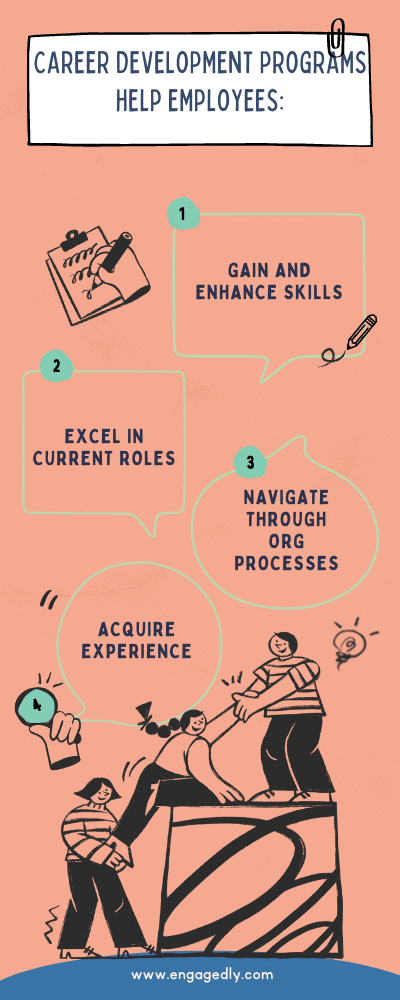
The program helps employees:
- Gain and enhance skills
- Excel in current roles
- Navigate through organizational systems
- Acquire experience to qualify for career advancement opportunities
Career development programs may be specific and timebound, but they are not set in stone. As and when an employee’s career path changes, the programs should undergo necessary alterations. A well-suited program coupled with the support coming from the company would bring about significant benefits that may positively impact all involved stakeholders.
Also Read: Importance, Implementation, and Benefits of Training and Development Program
10 Major Benefits of Implementing Employee Career Development Programs

The benefits of employee career development programs are not entirely exclusive to employees. Depending on the success and consistency of the programs, other stakeholders, such as the employer, may also experience improvements in various aspects. Here is a more comprehensive look at the different advantages of having an employee career development program:
1. Reduce attrition
Employees who do not see and experience career advancement in their current position are more likely to quit. When many employees think this way, the company will be in trouble because all dissatisfied individuals may resign simultaneously. This outcome is never ideal.
Companies must keep their employees satisfied with their jobs to prevent them from resigning. Besides compensation and benefits, a good career development program could be a valuable bargaining chip. It would be irrational for employees to work for many years in a company that does not promise any promotion.
Also Read: Why Your Business Needs This Foolproof “Talent Retention Strategy”
2. Encourage employees to work harder
It is not enough for employees to show up for work and do the minimum. If this habit continues, employees will become too complacent and deliver low-quality services and some may show signs of quitting. Ideally, employees should have the willingness to strive harder and perform better.
Implementing a career development program can help challenge employees to bring out their A game. Since they know they have goals to meet, they would consciously work hard to attain the said goals. A little work pressure will push them to move forward.
3. Inspire professional development among employees
There are multiple directions that employees can steer their careers toward. Most of the time, employees move their careers vertically or horizontally. Vertical career growth is about promotions and occupying a higher position, while horizontal career growth refers to a transfer to another industry or functional role.
Whether moving vertically or horizontally, having chances for professional development can strengthen employees’ love and respect for their jobs. They may reignite their passion for their careers and strive to be better.
4. Challenge employees to take on a new career path
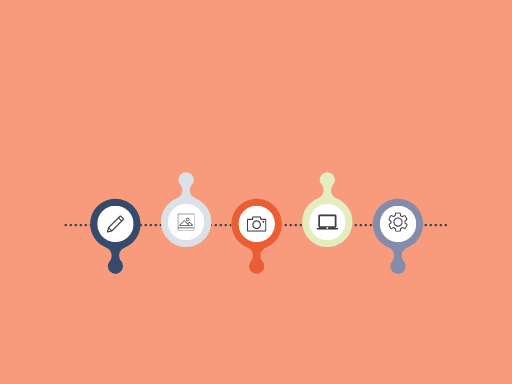
One may need to explore multiple options before settling into a chosen career. Even after establishing oneself in a selected position, it is still possible to change into something else.
Many employees are not satisfied with their current career paths. Thus, employers should provide opportunities for employees to explore other paths which could later contribute to their overall growth. Once they know what is out there, they feel more motivated to strive harder.
5. Survive unexpected crises
Before leading to better career opportunities, career development programs equip employees with skills that may or may not relate to their current jobs. These skills give them better competencies in varied professional aspects. Most importantly, these skills will prepare them for challenging circumstances.
As employees grow, they develop faster and better reactions against crises. More talented and experienced workers will help companies keep up with drastic changes. Their contributions will be crucial for the company’s survival.
6. Improve overall organizational performance
Besides technical skills, career development programs also focus on soft skills. Teamwork is one of the most relevant soft skills to learn across all industries. As employees grow, they also learn how to cooperate with others and carry out common goals.
Organization at the workplace promotes orderliness and efficiency. For co-workers, being able to work well with others could signify the existence of a peaceful and functional work culture. Workers should get along with one another.
Also Read: Create a Positive Workplace Culture For Your Employees
7. Reduce work-related errors
As employees do better in their respective positions, they are less likely to commit errors.
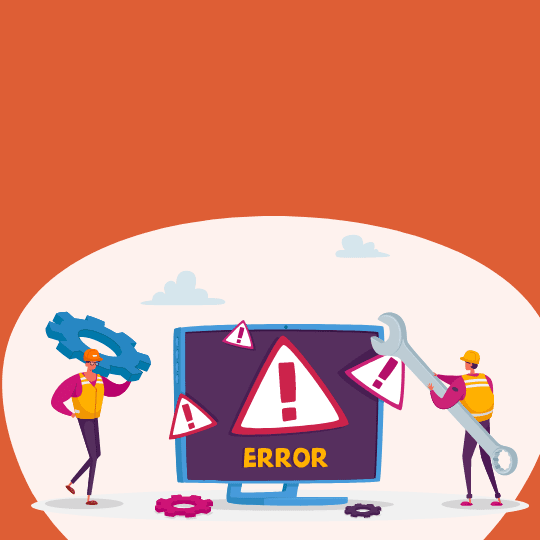
These errors cover technical difficulties that one might experience while working on projects and interpersonal issues that may cause toxicity in the workplace.
Climbing the corporate ladder can be daunting, so people need consistent and reliable support. Ideally, employees should have access to career development opportunities in managing pressure, stress, and other negative factors to prevent them from continuously committing mistakes.
8. Attract the best talent
Creating employee career growth plans and other similar programs can also be relevant to recruitment processes. After the company establishes a culture and system for its employees’ career advancement, the public will know, and applicants will become interested.
Talented and high-performing individuals can be picky with their employers, so attracting them with beneficial proposals is crucial. When these exemplary employees excel, naturally, the companies employing them will also experience a boost in productivity and performance.
9. Prepare for succession planning
Succession planning is a preemptive strategy that prevents the interruption of business and operations. It is about preparing employees to take on a higher and more challenging position in case the previous person on the job voluntarily or involuntarily quits.
This initiative helps companies forecast who could be the company’s next leaders. It is a preemptive measure that helps ensure organizational stability. For employees, having concrete succession planning is good motivation to work even harder.
10. Instill a progressive work culture

Implementing employee career growth plans may improve a company’s work culture. Aside from the encouragement employees get after knowing that something good can be attainable for performing well, they may also develop a sense of accountability to keep up with their responsibilities. While it takes time, this perspective can spread to all employees and make them more goal-oriented and competitive.
Career Development Trends in 2025
Looking ahead, several key trends are redefining career development:
- Personalized learning via AI – Generative AI tailors learning to individual goals, boosting satisfaction and retention.
- Career transparency & growth culture – Candidates expect open conversations about salary and promotion paths as standard.
- Hybrid & flexible upskilling – Remote-friendly, bite-sized reskilling programs shared across digital platforms are becoming essential.
End Note: Maximize Career Development Opportunities
Nowadays, there are endless ways for companies to foster employee career development. Besides onsite training and conventions, employers may also utilize career development e-learning courses for faster and more dynamic career progression. Regardless of how employers handle this situation, they should provide diverse improvement programs to accommodate employees’ varying needs and goals.

Frequently Asked Questions
Q1. What are the main benefits of career planning to an organization?
Ans. There are quite a few benefits in store for organizations who invest in an employee’s career planning, such as:
- Attracting and retaining good talent
- Promoting the brand image
- Utilizing resources to their fullest potential
- Preventing chaos and disruption in processes
Q2. What are the benefits of employee development and training?
Ans. Employee training is primarily about learning new skills and gaining specific knowledge that employees can apply immediately to make major gains in their current job positions, whereas development programs promote employees’ future performance and progress.
Q3. HOW CAN CAREER DEVELOPMENT PROGRAMS BENEFIT AN ORGANIZATION?
Ans. Career development programs benefit organizations by fostering a more skilled, engaged, and loyal workforce. They improve employee retention, boost productivity, and help build a leadership pipeline, which ensures the organization has strong talent ready to step into critical roles as needed.
Q4. WHAT ARE THE KEY COMPONENTS OF AN EFFECTIVE CAREER DEVELOPMENT PROGRAM?
Ans. An effective career development program typically includes components such as mentorship, training and development opportunities, career counseling, performance reviews, goal-setting processes, and access to resources for skill-building and professional growth.
Q5. WHO IS RESPONSIBLE FOR MANAGING A CAREER DEVELOPMENT PROGRAM?
Ans. The responsibility of managing a career development program usually falls on both HR professionals and organizational leaders. However, employees are also encouraged to take an active role in their career development by setting goals and seeking out opportunities for growth.
Here Are 6 Simple Tools To Measure Employee Engagement
Employee engagement is a common topic of discussion for all organizations globally. In the post-pandemic era where employees are still working remotely or working from home, the topic of employee engagement has gained center stage. Employees who are engaged tend to work harder and stay with the same company for a long time. Research by Gallup highlights that companies with highly engaged employees make 21% higher profits and 17% more productive when compared to others.
Employee engagement is not simply the happiness level or the quantity of work done by an employee; there is more to that. It is a workplace concept that relates to the level of commitment, connection, and motivation that employees have in their job roles, work, and the organization.
However, employees do not have the same level of engagement throughout; it fluctuates from time to time. To ensure that employee engagement is nurtured and measured, here are some tools:
- Reward and Recognition
- Employee Surveys
- One-on-Ones
- Exit and Stay Interviews
- Focus Group
- Measure Productivity Metrics and Retention Rate
Why Measuring Engagement in 2025 Needs Smarter Tools
In today’s hybrid and fast-moving workplaces, measuring employee engagement demands more than annual surveys. To stay relevant, tools must be real-time, analytics-driven, and predictive:
- Pulse surveys & eNPS tracking deliver frequent, actionable insights into employee sentiment and loyalty, helping HR respond rapidly to shifts.
- Engagement Index models, such as Quantum Workplace’s scientifically validated e9 model, measure nine core engagement drivers tied directly to business outcomes.
- AI-enhanced analytics extract sentiment and themes from open-ended responses, enabling faster, smarter insight into engagement trends.
Employee Reward And Recognition Programs
According to a recent study, 69% of employees would work harder if they felt their efforts were better appreciated.
Employee recognition and rewards activities are a good way to identify engaged employees. It is already known that recognition and rewards have a direct impact on employee engagement. The reverse also stands true, identifying the number of employees receiving rewards and recognition helps managers and HRs to identify employee engagement in their organization.
Also Read: Employee Rewards And Recognition For An Engaged Workforce
Frequent Employee Surveys
If you want quick and effective methods to measure employee engagement, then your go-to option should be to conduct surveys. It not only helps in measuring engagement, but it also helps in employee motivation, and getting ideas from employees. This two-way communication is very important in having an engaged workforce. HRs and managers should frequently send simple, small, and actionable surveys to the employees of the organization asking them about work. It will help HRs, managers, and the organization to know how engaged their employees are and also help them understand the temperament of the organization. Be sure to focus your survey questionnaire on three basic metrics: Satisfaction, Alignment, and Future orientation.
Engagedly’s built-in survey feature helps you create and assign surveys without a hitch.
Beyond Surveys: Smarter Metrics You Should Be Tracking
Consider these key metrics to deepen your measurement strategy:
- Participation Rate – The percentage of employees completing surveys; high participation correlates with engagement.
- Engagement Touchpoints – Monitor involvement in 1:1s, training programs, and peer recognition as supplemental engagement indicators.
- Demographic Insights – Breakdown scores by team, role, or tenure for targeted improvement actions.
- Feedback-to-Action Ratio – Measure the percentage of feedback items followed up with leadership action, reflecting true responsiveness.
Have Frequent One-On-Ones
From time to time, HR and managers should have one-to-one meetings with their employees. As one-to-one meetings are in person with the manager or the HR, the employee feels free to share information and express themselves. This should be done regularly, probably weekly once or every fortnight is advisable.
Also Read: Download the ultimate guide to employee engagement survey and templates
Conduct Exit And Stay Interviews
Employees leave the organization at different points in time, but as a manager or an HR, you need to know the actual cause behind it. Often employees cite that they didn’t feel engaged or excited with the work they do, as the reason behind leaving the organization. Conducting exit interviews and stay interviews helps the managers and the HRs to know which areas they should work on to improve employee engagement.
Exit interviews help in understanding what you could have done differently to improve engagement, whereas stay interviews let you know what you are already excelling at and what not.
Some common questions for both exit and stay interviews are:
- What do you like most about your job?
- What makes for a great day of work to you?
- What do you look forward to everyday at your work?
- What’s your relationship with your manager like?
- What do you dislike most about your job?
- If you could, what’s one thing you would change with your role?
- What makes you want to stay with this organization?
- What makes you want to leave this organization?
This helps prevent another employee from leaving the organization for the same reason.
Also Read: 7 Successful Strategies To Conduct A Stay Interview
Make Small Focus Groups
When organizations are very large it might be difficult for you to conduct a one-to-one meeting with your employees. In this case, focus groups could be formed. Often members of the same team or different teams can be grouped for this. As a manager, you should be prepared with a set of 5 to 8 questions, based on asking the employees whether they feel that their work is important or whether they have all the tools to do their work. This will help organizations to know what they can do to improve employee engagement and productivity.
Measure Productivity Metrics And Retention Rate
Retention rate and productivity metrics of employees will help determine how engaged the employees are in the organization. Employee engagement will have a direct effect on the retention rate and productivity metrics.
Thus it cannot be stressed enough how important employee engagement is and why it should be measured from time to time to keep your employees motivated and retain them in your organization. So if you have not been doing so, now is the time you should incorporate employee engagement measurement strategies and tools.

Case Study: What Makes the Best Tools Stand Out in 2025
At one HR summit, the WorkL Six-Step Engagement Framework—covering Recognition, Pride, Information Sharing, Empowerment, Well-Being, and Job Satisfaction—emerged as a research-based model aligning happiness with productivity. Companies scoring ≥70% across these drivers gained recognition as Best Places to Work. This underscores the value of holistic engagement measurement over standalone surveys.
Conclusion
In 2025, the best tools to measure employee engagement go far beyond static annual surveys. HR leaders now have access to real-time, AI-driven platforms that not only track engagement scores but also provide predictive insights and actionable recommendations. Whether through pulse surveys, eNPS tracking, sentiment analysis, or comprehensive Engagement Index models, modern measurement is about speed, accuracy, and strategic impact.
Organizations that invest in smarter engagement tools are better equipped to understand their workforce, close the feedback loop, and create a thriving, high-performance culture. The right tool doesn’t just measure engagement — it drives it forward.
Tools to Measure Employee Engagement – FAQs
Q1: How often should engagement be measured in 2025?
Shift from annual-only surveys to pulse surveys (monthly or quarterly) to stay abreast of evolving sentiment trends.
Q2: How does eNPS differ from the Engagement Index?
eNPS provides a snapshot of employee advocacy. In contrast, an Engagement Index (like e9) measures multiple drivers—including empowerment, recognition, and development—offering actionable insight.
Q3: Do AI tools truly enhance engagement measurement?
Absolutely—AI tools extract patterns from open responses, deliver sentiment insights, and highlight early warning signs of disengagement.
Must have Qualities of a Good Manager: 10 Important Skills You Need
Successful managers, exemplifying the qualities of a good manager, work towards fostering a positive work atmosphere, ensuring productivity, motivating their teams, and enhancing employees’ leadership qualities. Identifying an individual who can naturally strike this balance may be challenging, and the repercussions of selecting a poor boss can be disastrous.
One of the leading reasons for employee turnover is lousy management. According to a Gallup poll released recently, over half of all employees who quit a job do so because of their boss. This demonstrates the influence managers have on an organization’s performance, engagement, and retention.
Hiring new managers may seem like a difficult process, with its own set of challenges. However, there are data-backed characteristics of a successful manager that may assist you in making the best judgments.
Also read: Continuous Feedback: What Is It And Its Benefits
What makes a Good Manager?
Good management is key to a thriving team, but it’s not something everyone’s born with. The good news? It can be learned and strengthened over time. Even the most naturally gifted leaders can improve with the right training and support. That’s why ongoing development is so important—it helps managers stay sharp and adapt to new challenges.
So, what exactly makes a good manager? Let’s break it down by looking at the qualities that really matter. By focusing on these traits, you can help your managers become more effective, confident leaders who drive success for the whole team.
Top 10 Qualities of a Good Manager
Previously, experience and technical abilities were essential qualities of a good manager. However, today’s businesses put a larger focus on interpersonal skills like listening, flexibility, and encouraging open communication as far as the qualities of a good manager are concerned.

The efficient features that lead to a manager’s success include developing trust, demonstrating empathy, accepting responsibility, and engaging in employee development. Additionally, soft skills became an indispensable attribute of a manager. Let’s take a deeper look at the most important traits of a successful manager.
The following are the top qualities of a good manager:
- Effective Communication
- Strong Work Ethics
- Effective Goal Setting
- Knowledge Management
- Empowering and Inspiring the Team
- Supports Employees
- Upskilling Team Members
- Encouraging And Helpful
- Conflict Resolution and Problem-Solving Skills
- Leading by Example and Acting as a Role Model
1. Clear and Effective Communication
In order to communicate effectively with the employees, you need to follow certain guidelines, which would ensure that you, as a manager, and the employees are on the same page.
Connect Employees to the Bigger Picture
Every employee brings his or her own understanding to the workplace, a blend of culture, beliefs, upbringing, and accomplishments. As a manager, you must develop a common broader vision for the company’s employees.
You will create a silo mindset if you fail to provide the context and portray the bigger picture. Hence, employees wouldn’t appreciate the significance of their individual efforts.
In line with this, you, as a manager, should be certain that the employees are aware of the broader vision and how they fit within it.
Communicate the “why” behind the company’s strategy to the employees. To elaborate, why does the broader vision of the organization matter? What role does your team play? And, how valuable are employees’ contributions?
Ensure that you inform your employees of what is going on in the company and underline the value of their contributions and efforts to the company’s success.
Constant Communication To Build Trust and Credibility
Several studies have shown that hearing a message multiple times helps grasp its meaning. Communication isn’t a task that can be checked off as a to-do list. It’s all about delivering a message consistently among employees when it comes to building trust and confidence. Regular one-on-one meetings between managers and employees are an effective way to reinforce this communication and ensure alignment.
Also read: What Is Continuous Performance Management?
Initiate a Conversation To Make Sure Everyone Is on the Same Page
Communication allows you to see whether your employees understand your opinions on a variety of issues relating to business management and processes. After the information has been conveyed, double-check that it has been heard and comprehended.
You may also ask your employees to rephrase what they learned. If you want to determine if they have comprehended your core points or want extra context or depth, just ask, “What are your basic impressions and understanding of the information I just shared?”
With real-time two-way communication, you can monitor how effectively your messages are being received.
2. Strong Work Ethics
A manager may influence the dedication of the employees. One of the best qualities of a good manager is that they motivate employees and earn their loyalty, while a poor manager causes friction and that may cause significant attrition.
Effective Leadership
A successful manager has great leadership characteristics, sets a good example for their employees, and guides them toward the company’s goals. They are great decision-makers who utilize prudence and good judgment while being conscious of the impact their actions have on others.
Also read: 6 Most Common Leadership Challenges At Workplace
Sincere Concern
A competent manager cares about their employees and recognizes that happy employees are the foundation of a successful company. They encourage their employees to voice their concerns, while also showing sincere care in both their personal and professional lives.
They are sympathetic and willing to make adjustments when required, such as when their employees want vacation time. Rather than seeing you as just another employee, they want to get to know you as a person.
Accountability, Transparency, and Integrity
Integrity: A competent manager should be known for his or her honesty. A manager who includes truth and integrity in their system of belief sends a powerful message to subordinates.
Accountability: Accountability for one’s own mistakes rather than blaming others, accompanied by honest and polite comments, may help employees to improve their performance.
Transparency: It plays a significant role in inspiring and offering a clear understanding regarding the company’s requirements of the employees.
A Level Playing Field
Good employers handle all employees fairly, listening to and weighing all sides of employee disagreements before coming to a decision. They assign tasks to people based on their abilities over preferences.
Resilience
One of the appreciable qualities of a good manager is that they know how to deal with the successes and setbacks of business. Hence, they should exhibit patience and perseverance, as success does not materialize instantly as per one’s wishes.
When confronted with a problem, one should assess the issue objectively and understand when to stick to a plan and when to modify it. Often, if managers give up quickly in difficult circumstances, their employees may adopt their qualities.
3. Effective Goal Setting
A manager’s principal role is to create objectives for his or her employees. Qualities of a good manager include establishing specific goals and devising strategies with employees to achieve them.
Setting objectives in the workplace has a number of advantages.
- Aligning employees’ efforts with the company’s short-term and long-term objectives.
- Creating protocols and metrics for a successful employee performance evaluation and corporate incentive program.
- Increasing employee participation.
Also read: 7 Reasons Why Goal Setting Is Important
Here are some factors to think about while creating goals at the workplace:
Align Goals with the company’s objectives
The objectives of each employee should align with that of the organization. This can be achieved by communicating strategic business objectives frequently, along with team performance and the company’s growth targets.
Ask employees to come up with job-specific objectives
Managers might set specific goals for each employee, but asking employees for their own goals can often provide interesting insights. A manager may engage with employees to establish action plans to achieve their stated goals, conforming to the company’s objectives.
Establish SMART goals
Employees may be unsure of how to set work objectives that they can achieve with ease. In fact, oftentimes, employees start off with ambiguous or poorly worded goals, without any action plan to achieve them, which positions them for failure.
Instead, using the SMART (specific, measurable, attainable, relevant, and time-based) model, carefully structured with clear and trackable objectives, may help the cause. Each component of the SMART framework works together to establish limits, define the next actions, identify required resources, and provide success indicators.
If you break down long-term objectives into smaller chunks of objectives to be executed at a certain timeline, you can keep your team focused on the end goal while also making it simpler to execute each step.
4. Knowledge Management
Managers should have a thorough insight into their organization’s work processes and how they may lead to their company’s growth. Those who improve their employees’ abilities through knowledge sharing offer a positive example for employees to be engaged and educated throughout their careers. This might enhance the knowledge management process significantly.
The primary purpose of knowledge acquisition is to increase an organization’s efficiency and disseminate that information to its employees. To optimize an organization’s knowledge base, the manager should be able to contribute to the knowledge management process by providing valuable information that can be shared with all employees.
The objective is to facilitate corporate learning and foster a learning culture that encourages knowledge exchange.
5. Empowering and Inspiring the Team

Good managers turn out to be competent leaders who believe in the process of collaboration. For the same, they should ensure that each employee feels appreciated and motivated to succeed.
This can be achieved through positive feedback and when the employee shows a high level of involvement in the workplace. Make sure that each member of your team feels appreciated if you want them to succeed.
Best manager qualities include providing employees with constructive feedback, both on what they did well and on how they can improve.
Here are some suggestions for keeping people engaged and cheerful at work.
Give them a motivating goal
Giving employees a mission they understand and feel passionate about is an important aspect of keeping them engaged and enthused about their careers.
Motivation can come from a mission statement that makes it clear why all those long hours of work are worthwhile, rather than just talking about company profits.
Appreciate employees’ efforts
One of the primary reasons for employees losing interest in their jobs is that they believe their efforts are insignificant and their contribution does not make any difference to the company. Thus, acknowledging the employee’s efforts and guiding them to align their efforts with the company objectives makes a big difference.
You can motivate your employees by merely praising them for working extra over the weekend or for their innovative ideas at a meeting.
Also read: 5 Benefits of Investing In Employee Recognition Software
Maintain an open line of communication with them
Employees despise uncertainty about their job and feel insecure, which reduces their productivity. They will feel more involved and valued if you communicate with them honestly. Of course, not every piece of information should be shared with every employee at all times, but having a policy in place that communicates key things in a timely and professional way is critical for keeping employees engaged.
Encourage them to work together
Remote employees may feel like they aren’t part of the team, which might undermine their motivation. They should be encouraged to collaborate and learn from one another. Employee camaraderie goes a long way toward making one feel included. Most employees feel excited and enthusiastic while working as a team.
6. Supporting Employee Growth and Development
Nothing demotivates employees more than a manager who does not seem to be on their side. A manager’s main responsibility should be to assist his team in doing their duties and ensuring that they have the tools, feedback, and support they need to do so effectively. This is where manager coaching can play a crucial role in empowering employees and guiding them towards success.
You may serve as their advocate by talking with your employees, asking if they have any difficulties or queries, and advocating their best interests to the experienced ones.
7. Upskilling Team Members
Employees want to advance in their areas, companies, and professions. They remain engaged at work if they have possibilities for personal and professional development. Give them those precise and constructive comments so they can figure out how to enhance their performance.
Helping them enhance their performance will boost their self-esteem and make them happier at work. To achieve this, it’s crucial for managers to focus on development goals for work, ensuring they can effectively guide their teams towards growth and success.
Focusing on employee training and development ensures that team members are equipped with the necessary skills to grow and succeed in their roles.
Also read: How To Build A Successful Upskilling And Reskilling Program
8. Encouraging And Helpful
When team members do well, one of the admirable qualities of a good manager is that they give them credit and emphasize their accomplishments in briefings and performance evaluations, which helps them progress in their careers.
As a manager, you may assist your team in identifying their strengths and putting those skills to work on projects. Discuss individual team members’ professional objectives regularly.
9. Conflict Resolution and Problem-Solving Skills

Since every team includes diverse personalities, it’s critical for a skilled manager to have excellent dispute-resolution abilities. Understanding how to settle and arbitrate conflicts in a manner that makes employees feel appreciated is critical for keeping projects on track and employees’ morale high.
10. Leading by Example and Acting as a Role Model
Employees who see you as a role model may acquire the important abilities they need to succeed. To be a successful role model, show the values you want your team to have, such as honesty, openness, and a desire to accept more responsibilities.
Accepting responsibility may demonstrate to your colleagues that you are willing to learn from your errors. If you see a member demonstrating a favorable trait, be sure to compliment them. You can inspire your employees to emulate the attributes you expect from them by demonstrating them yourself.
How to Develop These Qualities: A 2025 Action Plan
For New Managers
- 90-day development roadmap
- Essential training programs
- Mentorship strategies
For Experienced Managers
- Advanced leadership certifications
- 360-feedback implementation
- Executive coaching benefits
For Organizations
- Manager training program design
- Leadership assessment tools
- Succession planning frameworks
Common Management Mistakes to Avoid in 2025
- Over-relying on digital communication
- Ignoring mental health and wellbeing
- Failing to adapt to remote work dynamics
- Neglecting diversity, equity, and inclusion
Tools and Resources for Better Management
Digital Management Tools
- Project management software (Asana, Monday.com)
- Communication platforms (Slack, Microsoft Teams)
- Performance tracking tools (15Five, BambooHR)
Assessment and Development Resources
- Leadership assessment frameworks
- 360-feedback tools
- Management training platforms
Industry-Specific Management Considerations
- Tech industry management
- Healthcare team leadership
- Remote team management
- Global team coordination
Other Important Qualities of a Good Manager
Some other qualities of a manager that have become relevant in the current business environment include:
- Adaptability – The ability to quickly adjust to changes in the business environment and industry trends is essential for a manager’s success in the current business landscape.
- Strategic thinking – In order to navigate the complex and ever-changing business environment, a good manager must be able to think strategically and make informed decisions that are in line with the organization’s goals.
- Emotional intelligence – A good manager should be able to understand and manage their own emotions, as well as those of their team members. This includes the ability to build strong relationships and handle conflicts effectively.
- Results-driven – In the current business environment, achieving results and meeting objectives is more important than ever. A good manager should be able to set clear goals and expectations and hold their team accountable for delivering results.
- Innovation – The ability to think creatively and come up with innovative solutions is highly valued in today’s business environment. A good manager should be able to encourage and facilitate innovation within their team.

Request a demo with us to learn how Engagedly can help you identify your strengths and weaknesses to help you become a good manager!
Qualities of a good manager FAQ
1. What are the most important qualities of a good manager?
A good manager should have strong communication skills, the ability to motivate and inspire their team, emotional intelligence, decisiveness, adaptability, and a results-oriented mindset. They should also lead by example and be open to feedback.
2. How can I tell if someone is a good manager?
A good manager builds trust within their team, communicates openly, and handles challenges with a level-headed approach. If the team feels supported, motivated, and understands their goals, it’s a strong sign of good management.
3. Why is emotional intelligence one of the key qualities of a good manager?
Emotional intelligence helps managers understand and respond to the emotions of their team members. This quality enables them to handle conflicts, provide support, and create a positive work atmosphere where people feel understood and valued.
Staff Augmentation Guide 2025: Best Practices & Implementation Strategies
Staffing is probably one of the most challenging business activities to manage as a business owner. Staffing typically includes hiring employees through a lengthy hiring process, training them, keeping them motivated, investing in development, and transferring roles, only for them to possibly leave sooner than expected.
This becomes frustrating and can end up being quite costly to businesses. When employees leave a company, it can also create big disruptions in the workflow of the business. This is where resource and staff augmentation as a hiring model becomes a very effective solution for staffing.
What is Staff Augmentation?
Staff augmentation is an outsourcing strategy to hire temporary personnel for a project or to augment the capacity of the organization as per business objectives. It involves inquiring into the existing skills of the workforce and determining the additional skills required for successful business delivery.
personnel are usually hired through an agency. Businesses in need of temporary staff members will contact the agency and offer a description of the type of employees required. The agency will then research its database of potential employees and put forward the best candidates.
Therefore, it is of great importance that businesses give their preferred agencies a detailed description of which skills and experience are required. Once suitable candidates have been chosen, they will be contracted between the business and the agency for a predetermined time and at a certain rate.
Also read: Getting started with real time performance management
Workforce augmentation has become increasingly popular with businesses because of the benefits involved. Especially the IT industry is using staff augmentation as a hiring model because their staff turnover is often higher in comparison with other industries.
When do Businesses Turn to Staff Augmentation?
Many scenarios can drive the need for staff augmentation in a business. Let’s look at three different scenarios:
Scenario 1:
When a business takes on a new project but does not have the staffing capacity or resources to train new employees to complete the project in the timeframe required.
Scenario 2:
When an employee leaves a company in the pursuit of a new opportunity or even just for annual leave, there is a gap in the workforce. This can slow down the company’s entire workflow.
Scenario 3:
While a business is looking for the best permanent team to hire, staff augmentation acts as a bridge. This ensures continuity in the business.
These scenarios are just three examples where staff augmentation can be a highly effective hiring solution for businesses. But there are many other times businesses can also benefit from augmenting staff. It is, however, mainly due to a lack of or limited access to resources.
What are the Benefits of Staff Augmentation?
Staff augmentation is increasingly becoming one of the most sought after recruitment models because it offers so many benefits to businesses. Some of these include:
More access to skills
When using staff augmentation services, businesses have access to a larger talent pool with a greater variety of skills. This talent pool is accessible at short notice and when required.
Also read: How to build a successful upskilling and reskilling program
Easy scalability
Workforce augmentation offers great mitigation for running the risk of having no capacity to take on and complete new projects or not sticking to deadlines. Businesses can quickly scale up or down when needed without having to deal with employee changes or paying high HR costs.
Lower operating costs
It is much more affordable for businesses to hire already qualified and vetted employees from an outsourcing agency than going through the sourcing and hiring process directly. Employing directly takes valuable time, effort and money out of businesses.
Higher efficiency
Being efficient is what business is about these days. Delivering the best results in the shortest amount of time. It is much easier to achieve this with staff that are already trained and ready to do business. Staff augmentation is a good choice when it comes to looking for higher efficiency.
Higher efficiency
Hiring full-time employees requires someone in the business to mentor the newly employed staff. This mentoring can include training them, explaining objectives, setting goals, and more. With staff augmentation, employees already have and ready to fit in with businesses, saving valuable time and money.
Staff Augmentation Security & Compliance in 2025
With increasing cyber threats and regulatory requirements, security considerations are paramount when implementing staff augmentation:
Data Protection Protocols
– Implement robust access controls and multi-factor authentication
– Ensure all augmented staff sign comprehensive NDAs and security agreements
– Regular security training and compliance updates for external team members
– Encrypted communication channels and secure file sharing systems
Regulatory Compliance
– GDPR compliance for European data handling
– HIPAA requirements for healthcare-related projects
– SOX compliance for financial services augmentation
– Industry-specific certifications and clearances
Risk Assessment Framework
1. Vendor Security Audits: Thorough evaluation of agency security practices
2. Background Checks: Comprehensive screening of augmented personnel
3. Ongoing Monitoring: Regular security assessments and compliance reviews
4. Incident Response Plans: Clear protocols for security breaches or data incidents
Staff Augmentation Best Practices
When managed effectively, staff augmentation can save businesses a lot of valuable time, effort, money, and other resources. Let’s explore some of the augmented workforce techniques and tips to make it work optimally:
1. Establishing goals and objectives
Before turning to staff augmentation, it’s critical to define the goals and objectives of the project. This clarity helps guide both the internal team and the augmented staff toward a shared understanding of the project’s direction. Establishing goals can involve identifying specific tasks, expected outcomes, timelines, and deliverables.
2. Identifying any gaps
Before hiring, businesses should conduct a thorough gap analysis to identify which specific skills are lacking within their internal team. This helps avoid redundancies and ensures that only the most critical skills are brought on board through staff augmentation. A targeted approach increases the effectiveness of the project and prevents hiring overqualified or underqualified professionals.
3. Reviewing and Vetting Agencies
Choosing the right staffing agency can make or break the success of your augmented workforce. Not all agencies are equal, so it’s important to review multiple agencies to compare their rates, expertise, access to talent, and working processes. It’s also essential to check reviews from previous clients, examine case studies, and assess the agency’s track record in delivering similar projects.
4. Offering effective leadership
While augmented staff members are often highly skilled, they still require leadership to perform optimally within the organization’s structure. Clear leadership helps them align with internal teams, stay on track with deliverables, and communicate effectively. Assigning a project manager or team leader to oversee the augmented workforce can foster collaboration and maintain accountability.
5. Offering a strong onboarding process
Even though augmented staff members are often remote or temporary, they need to be onboarded properly into the company’s processes and culture. An effective onboarding process introduces them to key tools, systems, workflows, and objectives. Without this, they might feel disconnected, which can hinder productivity and lead to misaligned deliverables.
Also read: Virtual Onboarding: A New Reality
6. Respecting differences
Augmented staff often work remotely from different countries and come with diverse cultural backgrounds. To ensure smooth collaboration, it is important to acknowledge and respect these cultural differences, whether it’s the way they communicate, their work schedule, or their approach to problem-solving. Creating an inclusive work environment where everyone feels valued is key to maintaining harmony and productivity.
7. Offering recognition
Just like full-time employees, augmented staff need recognition to feel motivated and engaged. Offering praise when due, providing constructive feedback, and showing appreciation for their work can go a long way in keeping morale high. Remote or temporary workers often feel isolated, and a simple acknowledgment of their contributions can help them feel more connected to the organization.
2025 Staff Augmentation Trends & Technologies:
The staff augmentation landscape is rapidly evolving with new technologies and methodologies:
AI-Driven Talent Matching:
Advanced algorithms now match candidates based on:
– Technical skill compatibility scores
– Cultural fit assessments
– Project success prediction models
– Real-time availability and capacity analysis
Hybrid Augmentation Models:
– Human + AI Teams: Combining human expertise with AI tools for enhanced productivity
– Nearshore + Offshore: Strategic geographic distribution for cost optimization and time zone coverage
– Full-Stack Augmentation: Complete team augmentation including project management and QA
Sustainability & Ethical Practices:
Modern staff augmentation emphasizes:
– Fair wage practices and ethical hiring standards
– Environmental sustainability in remote work setups
– Diversity, equity, and inclusion in talent sourcing
– Carbon footprint reduction through strategic geographic placement
Staff Augmentation in a Nutshell
Today, IT staff augmentation services are an effective solution to fill the gaps in a business’s workforce while still maintaining the quality of its systems and processes. Staff augmentation can also be a cost-effective solution for staffing needs because there is no need to invest in office space or other hiring costs tied to traditional staffing methods.
Get in touch with us to know how we at Engagedly have helped transform organizations with our Real Time Performance Management Software.




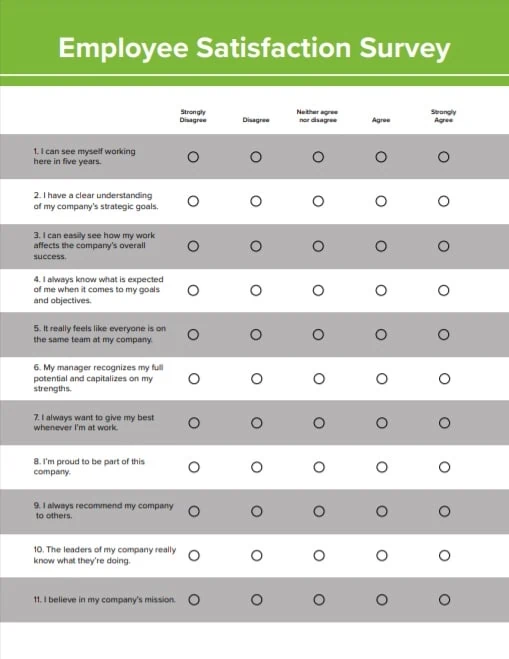


 BCG highlights
BCG highlights


